
Modern architecture or modernist architecture is a term applied to a group of styles of architecture which emerged in the first half of the 20th century and became dominant after World War II. It was based upon new technologies of construction, particularly the use of glass, steel and reinforced concrete; and upon a rejection of the traditional neoclassical architecture and Beaux-Arts styles that were popular in the 19th century. Modern architecture continued to be the dominant architectural style for institutional and corporate buildings into 1980s, when it was challenged by postmodernism, and then by "neo-modernism" and other schools which gradually supplanted it. Notable architects important to the history and development of the modernist movement include Frank Lloyd Wright, Ludwig Mies van der Rohe, Le Corbusier, Walter Gropius, Konstantin Melnikov, Erich Mendelsohn, Richard Neutra, Louis Sullivan, Gerrit Rietveld, Bruno Taut, Gunnar Asplund, Arne Jacobsen, Oscar Niemeyer and Alvar Aalto.
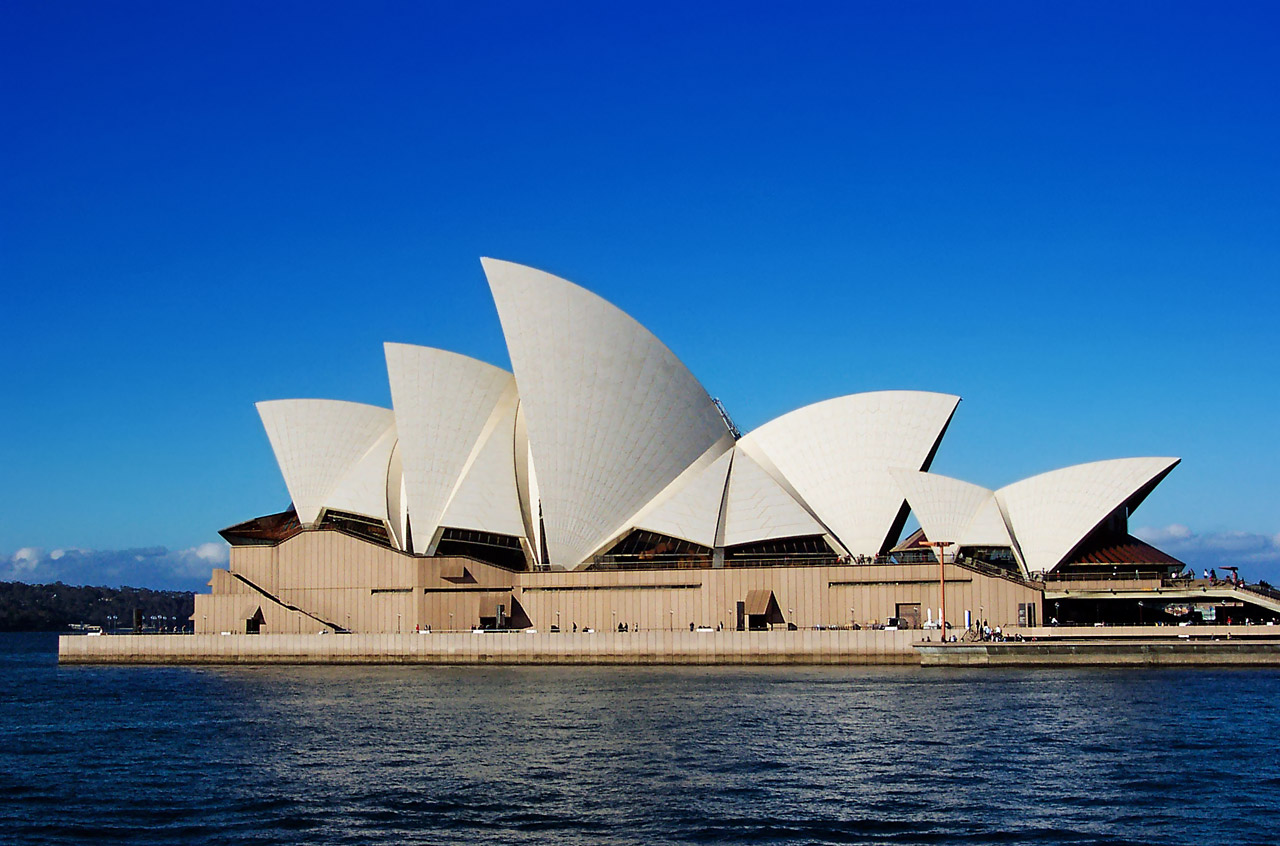
Origins
Modern architecture emerged at the end of the 19th century from revolutions in technology, engineering and building materials, and from a desire to break away from historical architectural styles and to invent something that was purely functional and new.
The revolution in materials came first, with the use of cast iron, plate glass, and reinforced concrete, to build structures that were stronger, lighter and taller. The cast plate glass process was invented in 1848, allowing the manufacture of very large windows. The Crystal Palace by Joseph Paxton at the Great Exhibition of 1851 was an early example of iron and plate glass construction, followed in 1864 by the first glass and metal curtain wall. These developments together led to the first steel-framed skyscraper, the ten-story Home Insurance Building in Chicago, built in 1884 by William Le Baron Jenney. The iron frame construction of the Eiffel Tower, then the tallest structure in the world, captured the imagination of millions of visitors to the 1889 Paris Universal Exposition.

The first house of reinforced concrete in Saint-Denis near Paris,
designed by François Coignet (1853)
French industrialist François Coignet was the first to use iron-reinforced concrete, that is, concrete strengthened with iron bars, as a technique for constructing buildings. In 1853 Coignet built the first iron reinforced concrete structure, a four-story house in the suburbs of Paris. A further important step forward was the invention of the safety elevator by Elisha Otis, first demonstrated at the Crystal Palace exposition in 1852, which made tall office and apartment buildings practical. Another important technology for the new architecture was electric light, which greatly reduced the inherent danger of fires caused by gas in the 19th century.
The debut of new materials and techniques inspired architects to break away from the neoclassical and eclectic models that dominated European and American architecture in the late 19th century, most notably eclecticism, Victorian and Edwardian architecture, and the Beaux-Arts architectural style. This break with the past was particularly urged by the architectural theorist and historian Eugène Viollet-le-Duc. In his 1872 book Entretiens sur L'Architecture, he urged: "use the means and knowledge given to us by our times, without the intervening traditions which are no longer viable today, and in that way we can inaugurate a new architecture. For each function its material; for each material its form and its ornament." This book influenced a generation of architects, including Louis Sullivan, Victor Horta, Hector Guimard, and Antoni Gaudí.
The Eiffel Tower being constructed (August 1887-89)
Early modernism in Europe (1900-1914)
At the end of the 19th century, a few architects began to challenge the traditional Beaux Arts and Neoclassical styles that dominated architecture in Europe and the United States. The Glasgow School of Art 1896-99) designed by Charles Rennie MacIntosh, had a facade dominated by large vertical bays of windows. The Art Nouveau style was launched in the 1890s by Victor Horta in Belgium and Hector Guimard in France; it introduced new styles of decoration, based on vegetal and floral forms. In Barcelona, Antonio Gaudi conceived architecture as a form of sculpture; the facade of the Casa Battlo in Barcelona (1904-1907) had no straight lines; it was encrusted with colorful mosaics of stone and ceramic tiles.

The Glasgow School of Art by Charles Rennie MacIntosh (1896-99)
Architects also began to experiment with new materials and techniques, which gave them greater freedom to create new forms. In 1903-1904 in Paris Auguste Perret and Henri Sauvage began to use reinforced concrete, previously only used for industrial structures, to build apartment buildings. Reinforced concrete, which could be molded into any shape, and which could create enormous spaces without the need of supporting pillars, replaced stone and brick as the primary material for modernist architects. The first concrete apartment buildings by Perret and Sauvage were covered with ceramic tiles, but in 1905 Perret built the first concrete parking garage on 51 rue de Ponthieu in Paris; here the concrete was left bare, and the space between the concrete was filled with glass windows. Henri Sauvage added another construction innovation in an apartment building on Rue Vavin in Paris (1912-1914); the reinforced concrete building was in steps, with each floor set back from the floor below, creating a series of terraces. Between 1910 and 1913, Auguste Perret built the Théâtre des Champs-Élysées, a masterpiece of reinforced concrete construction, with Art Deco sculptural bas-reliefs on the facade by Antoine Bourdelle. Because of the concrete construction, no columns blocked the spectator's view of the stage.
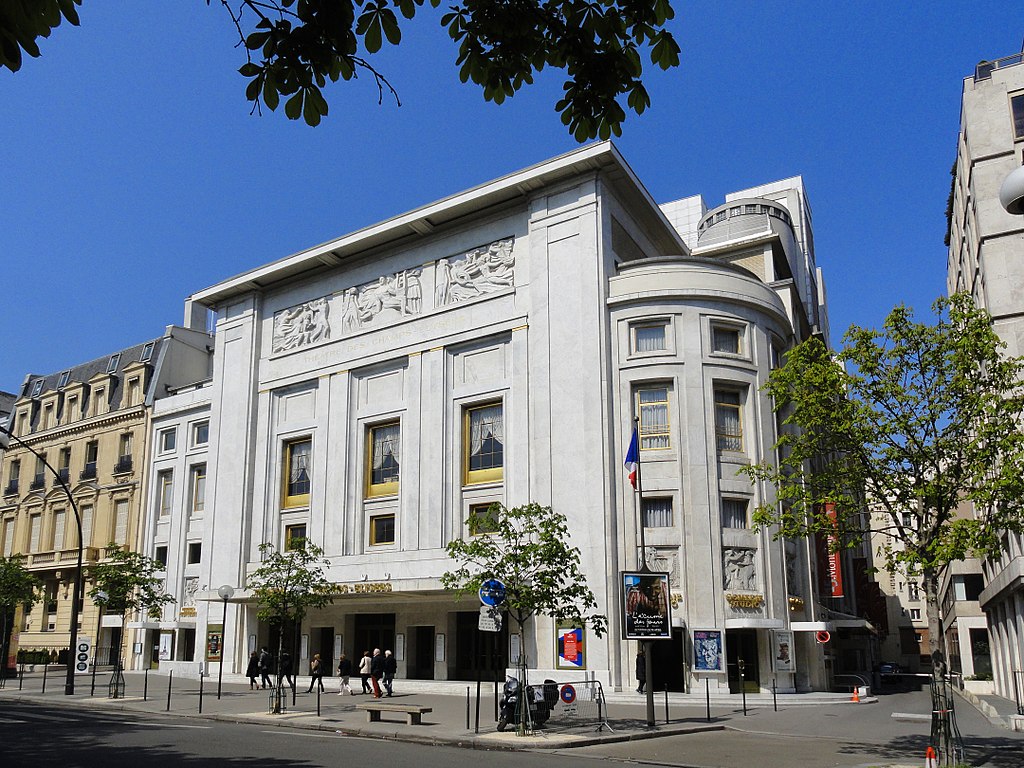
The Théâtre des Champs-Élysées in Paris by Auguste Perret (1911-1913)
Otto Wagner, in Vienna, was another pioneer of the new style. In his book Moderne Architektur (1895) he had called for a more rationalist style of architecture, based on "modern life". He designed a stylized ornamental metro station at Karlsplatz in Vienna (1888-89), then an ornamental Art Nouveau residence, Majolika House (1898), before moving to a much more geometric and simplified style, without ornament, in the Austrian Postal Savings Bank (1904-1906). Wagner declared his intention to express the function of the building in its exterior. The reinforced concrete exterior was covered with plaques of marble attached with bolts of polished aluminum. The interior was purely functional and spare, a large open space of steel, glass and concrete where the only decoration was the structure itself.

The Fagus Factory in Alfeld by Walter Gropius and Adolf Meyer (1911–13)
The Viennese architect Adolf Loos also began removing any ornament from his buildings. His Steiner House, in Vienna (1910), was an example of what he called rationalist architecture; it had a simple stucco rectangular facade with square windows and no ornament. . The fame of the new movement, which became known as the Vienna Secession spread beyond Austria. Josef Hoffmann, a student of Wagner, constructed a landmark of early modernist architecture, the Palais Stoclet, in Brussels, in 1906-1911. This residence, built of brick covered with Norwegian marble, was composed of geometric blocks, wings and a tower. A large pool in front of the house reflected its cubic forms. The interior was decorated with paintings by Gustav Klimt and other artists, and the architect even designed clothing for the family to match the architecture.

Stepped concrete apartment building in Paris by Henri Sauvage (1912-1914)
In Germany, a modernist industrial movement, Deutscher Werkbund (German Work Federation) had been created in Munich in 1907 by Hermann Muthesius, a prominent architectural commentator. Its goal was to bring together designers and industrialists, to turn out well-designed, high quality products, and in the process to invent a new type of architecture. The organization originally included twelve architects and twelve business firms, but quickly expanded. The architects include Peter Behrens, Theodor Fischer (who served as its first president), Josef Hoffmann and Richard Riemerschmid. In 1909 Behrens designed one of the earliest and most influential industrial buildings in the modernist style, the AEG turbine factory, a functional monument of steel and concrete. In 1911-1913, Adolf Meyer and Walter Gropius, who had both worked for Behrens, built another revolutionary industrial plant, the Fagus factory in Alfeld an der Leine, a building without ornament where every construction element was on display. The Werkbund organized a major exposition of modernist design in Cologne just a few weeks before the outbreak of the First World War in August 1914. For the 1914 Cologne exhibition, Bruno Taut built a revolutionary glass pavilion.

Early American modernism (1900-1914)
Frank Lloyd Wright was a highly original and independent American architect who refused to be categorized in any one architectural movement. Like Le Corbusier and Ludwig Mies van der Rohe, he had no formal architectural training. In 1887-93 he worked in the Chicago office of Louis Sullivan, who pioneered the first tall steel-frame office buildings in Chicago, and who famously stated "form follows function." Wright set out to break all the traditional rules. Wright was particularly famous for his Prairie Houses, including the Winslow House in River Forest, Illinois(1893-94),;Arthur Heurtley House (1902) and Robie House (1909); sprawling, geometric residences without decoration, with strong horizontal lines which seemed to grow out of the earth, and which echoed the wide flat spaces of the American prairie. His Larkin Building (1904-1906) in Buffalo, New York, Unity Temple (1905) in Oak Park, Illinois and Unity Temple had highly original forms and no connection with historical precedents.

The Robie House by Frank Lloyd Wright, Chicago (1909)
The Birth of the skyscraper
At the end of the 19th century, the first skyscrapers began to appear in the United States. They were a response to the shortage of land and high cost of real estate in the center of the fast-growing American cities, and the availability of new technologies, including fireproof steel frames and improvements in the safety elevator invented by Elisha Otis in 1852. The first steel-framed "skyscraper", The Home Insurance Building in Chicago, was ten stories high. It was designed by William Le Baron Jenney in 1883, and was briefly the tallest building in the world. It was surpassed by the (Home Insurance Building) of Louis Sullivan in Buffalo, New York. Sullivan built another monumental new structure, the Carson, Pirie, Scott and Company Building, in the heart of Chicago in 1904-06. While these buildings were revolutionary in their steel frames and height, the designs of their facades were in the more traditional neo-renaissance, Neo-Gothic and Beaux-Arts architecture. The Woolworth Building, designed by Cass Gilbert, was completed in 1912, and was the tallest building in the world until the completion of the Chrysler Building in 1929. Its exterior was in the Neo-Gothic style, complete with decorative buttresses, arches and spires, which caused it be nicknamed the "Cathedral of Commerce".
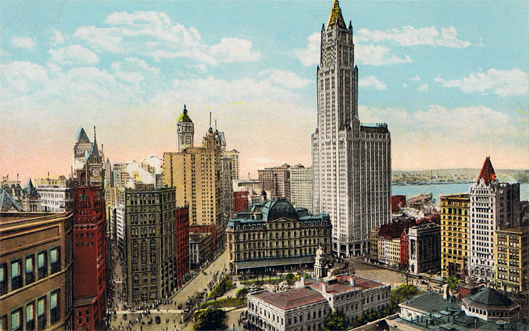
The Woolworth Building and the New York skyline in 1913.
It was modern on the inside but neo-Gothic on the outside.
The Rise of Modernism (1919-1930)
After the first World War, a prolonged struggle began between architects who favored the more traditional styles of neo-classicism and the Beaux-Arts architecture style, and the modernists, led by Le Corbusier and Robert Mallet-Stevens in France, Walter Gropius and Ludwig Mies van der Rohe in Germany, and Konstantin Melnikov in the new Soviet Union, who wanted only pure forms and the elimination of any decoration. Art Deco architects such as Auguste Perret and Henri Sauvage often made a compromise between the two, combining modernist forms and stylized decoration.

Corbusier Haus in Weissenhof Estate, Stuttgart, Germany (1927)
Le Corbusier and Mallet-Stevens
The dominant figure in the rise of modernism in France was Charles-Édouard Jeanneret, a Swiss-French architect who in 1920 took the name Le Corbusier. In 1920 he co-founded a journal called 'L'Espirit Nouveau and energetically promoted architecture that was functional, pure, and free of any decoration or historical associations. He was also a passionate advocate of a new urbanism, based on planned cities. In 1922 he presented a design of a city for three million people, whose inhabitants lived in identical sixty-story tall skyscrapers surrounded by open parkland. He designed modular houses, which would be mass-produced on the same plan and assembled into apartment blocks, neighborhoods and cities. In 1923 he published "Toward an Architecture", with his famous slogan, "a house is a machine for living in." He tirelessly promoted his ideas through slogans, articles, books, conferences, and participation in Expositions.
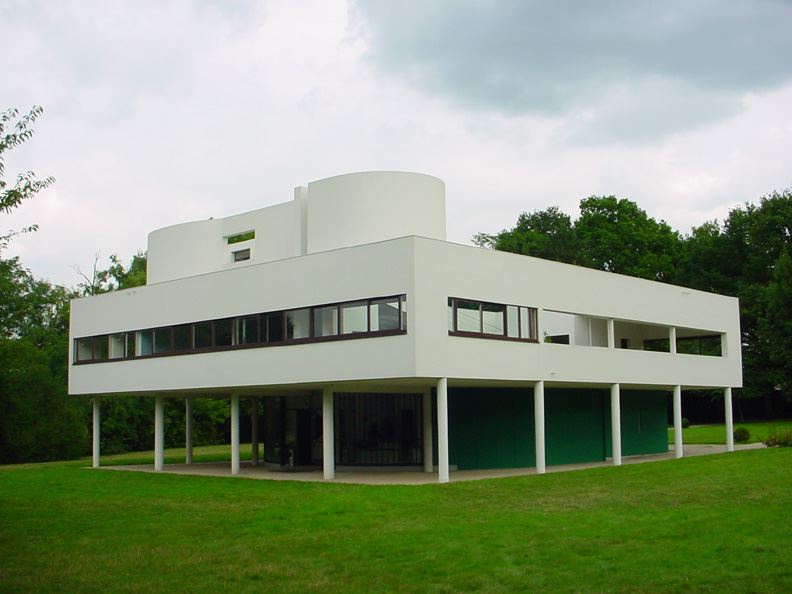
The Villa Savoye in Poissy by Le Corbusier (1928-31)
To illustrate his ideas, in the 1920s he built a series of houses and villas in and around Paris. They were all built according to a common system, based upon the use of reinforced concrete, and of reinforced concrete pylons in the interior which supported the structure, allowing glass curtain walls on the facade and open floor plans, independent of the structure. They were always white, and had no ornament or decoration on the outside or inside. The best-known of these houses was the Villa Savoye, built in 1928-1931 in the Paris suburb of Poissy. An elegant white box wrapped with a ribbon of glass windows around on the facade, with living space that opened upon an interior garden and countryside around, raised up by a row of white pylons in the center of a large lawn, it became an icon of modernist architecture.

Hôtel Martel rue Mallet-Stevens, by Robert Mallet-Stevens (1926-1927)
The Bauhaus and the German Werkbund
In Germany, two important modernist movements appeared after the first World War, The Bauhaus was a school organized Weimar in 1919 under the direction of Walter Gropius. Gropius was the son of the official state architect of Berlin, who studied before the war with Peter Behrens, and designed the modernist Fagus turbine factory. The Bauhaus was a fusion of the prewar Academy of Arts and the school of technology. In 1926 it was transferred from Weimar to Dessau; Gropius designed the new school and student dormitories in the new, purely functional modernist style he was encouraging. The school brought together modernists in all fields; the faculty included the modernist painters Vasily Kandinsky, Joseph Albers and Paul Klee, and the designer Marcel Breuer.
The Bauhaus school building at Dessau, Germany,
designed by Walter Gropius (1926)
Gropius became an important theorist of modernism, writing ‘’The Idea and Construction’’ in 1923. He was an advocate of standardization in architecture, and the mass construction of rationally-designed apartment blocks for factory workers. In 1928 he was commissioned by the Siemens company to build apartment for workers in the suburbs of Berlin, and in 1929 he proposed the construction of clusters of slender eight to ten story high rise apartment towers for workers.
A Bauhaus design for a worker's apartment, by Walter Gropius(1928-30)
While Gropius was active at the Bauhaus, Ludwig Mies van der Rohe led the modernist architectural movement in Berlin. Inspired by the De Stijl movement in the Netherlands, he build clusters of concrete summer houses and proposed a project for a glass office tower. He became the vice president of the German ‘’Werkbund’’, and became the head of the Bauhaus from 1930 to 1932. proposing a wide variety of modernist plans for urban reconstruction. His most famous modernist work was the German pavilion for the 1929 international exposition in Barcelona. It was a work of pure modernism, with glass and concrete walls and clean, horizontal lines. Though it was only a temporary structure, and was torn down in 1930, it became, along with Le Corbusier's Villa Savoye, one of best-known landmarks of modernist architecture. A reconstructed version now stands on the original site in Barcelona.

The Barcelona Pavilion (modern reconstruction) by Ludwig Mies van der Rohe (1929)
When the Nazis came to power in Germany, they viewed the Bauhaus as a training ground for communists, and closed the school in 1932. Gropius left Germany and went to England, then to the United States, where he and Marcel Breuer both joined the faculty of the Harvard Graduate School of Design, and became the teachers of a generation of American postwar architects. In 1937 Mies van der Rohe also moved to the United States; he became one of the most famous designers of postwar American skyscrapers.

The Einstein Tower by Erich Mendelsohn (1920–24)
German Expressionism (1919-1933)
Expressionism, which appeared in Germany between 1910 and 1925, was a counter-movement against the strictly functional architecture of the Bauhaus and Werkbund. Its advocates, including Bruno Taut, Hans Poelzig, Fritz Hoger and Erich Mendelsohn, wanted to create architecture that was poetic, expressive, and optimistic. Many expressionist architects had fought in World War I and their experiences, combined with the political turmoil and social upheaval that followed the German Revolution of 1919, resulted in a utopian outlook and a romantic socialist agenda. Economic conditions severely limited the number of built commissions between 1914 and the mid-1920s, As result, many of the most innovative expressionist projects, including Bruno Taut's Alpine Architecture and Hermann Finsterlin's Formspiels, remained on paper. Scenography for theatre and films provided another outlet for the expressionist imagination, and provided supplemental incomes for designers attempting to challenge conventions in a harsh economic climate. A particular type, using bricks to create its forms (rather than concrete) is known as Brick Expressionism.

The Mossehaus in Berlin by Erich Mendelsohn,
an early example of streamline moderne (1921–23)
Erich Mendelsohn, (who disliked the term Expressionism for his work) began his career designing churches, silos, and factories which were highly imaginative, but, for lack of resources, were never built In 1920, he finally was able to construct one of his works in the city of Potsdam; an observatory and research center called the Einsteinium, named in tribute to Albert Einstein. It was supposed to be built of reinforced concrete, but because of technical problems it was finally built of traditional materials covered with plaster. His sculptural form, very different from the austere rectangular forms of the Bauhaus, first won him commissions to build movie theaters and retail stores in Stuttgart, Nuremberg and Berlin. His Mossehaus in Berlin was an early model for the streamline moderne style. His Columbushaus on Potsdamer Platz in Berlin (1931) was a prototype for the modernist office buildings that followed. (It was torn down in 1957, because it stood in the zone between East and West Berlin, where the Berlin Wall was constructed.) Following the rise of the Nazis to power, he moved to England (1933), then to the United States (1941).

Horseshoe-shaped public housing project by Bruno Taut (1925)
Fritz Höger was another notable Expressionist architect of the period. His Chilehaus was built as the headquarters of a shipping company, and was modeled after a giant steamship, a triangual building with a sharply pointed bow. It was constructed of dark brick, and used external piers to express its vertical structure. Its external decoration borrowed from Gothic cathedrals, as did its internal arcades. Hans Poelzig was another notable expressionist architect. In 1919 he built the Großes Schauspielhaus, an immense theater in Berlin, seating five thousand spectators for theater impresario Max Reinhardt. It featured elongated shapes like stalagmites hanging down from its gigantic dome, and lights on massive columns in its foyer. He also constructed the IG Farben building, a massive corporate headquarters, now the main building of Goethe University in Frankfurt. Bruno Taut specialized in building large scale apartment complexes for working-class Berliners. He built twelve thousand individual units, sometimes in buildings with unusual shapes, such as a giant horseshoe. Unlike most other modernists, he used bright exterior colors to give his buildings more life The use of dark brick in the German projects gave that particular style a name, Brick Expressionism.
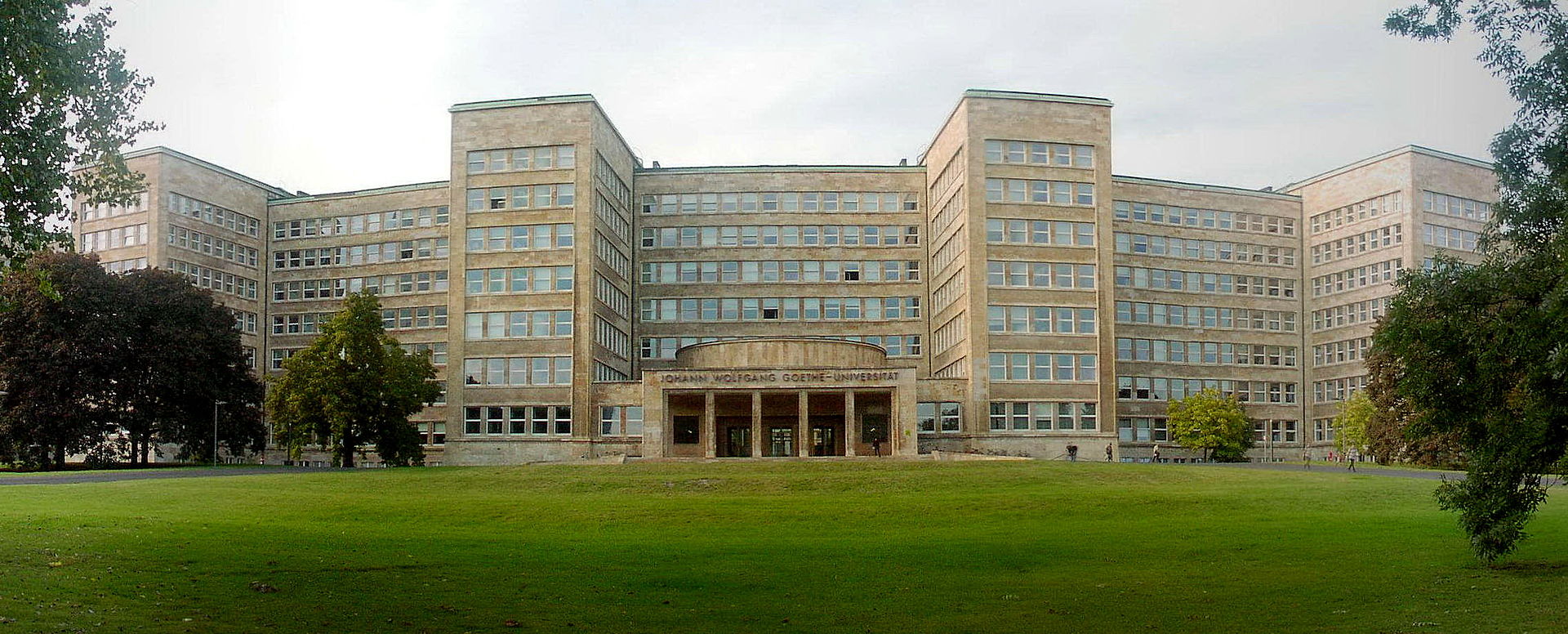
The main building of Goethe University, originally the IG Farben Building in Frankfurt,
designed by Hans Poelzig (1928–30)
The Austrian philosopher, architect and social critic Rudolf Steiner also departed as far as possible from traditional architectural forms. His Second Goetheanum, built from 1926 near Basel, Switzerland the Einsteinturm in Potsdam, Germany, and the Second Goetheanum, by Rudolf Steiner (1926), were based on no traditional models, and had entirely original shapes.

The Chilehaus in Hamburg by Fritz Höger (1921–24)
Soviet Constructivism (1919-1930)
After the Russian Revolution of 1917, Russian avant-garde artists and architects began searching for a new Soviet style which could replace traditional neoclassicism. The new architectural movements were closely tied with the literary and artistic movements of the period, the futurism of poet Vladimir Mayakovskiy, the Suprematism of painter Kasimir Malevich, and the colorful Rayonism of painter Mikhail Larionov. The most startling design that emerged was the tower proposed by painter and sculptor Vladimir Tatlin for the Moscow meeting of the Third Communist International in 1920: he proposed two interlaced towers of metal four hundred meters high, with four geometric volumes suspended from cables. The movement of Russian Constructivist architecture was launched in 1921 by a group of artists led by Aleksandr Rodchenko. Their manifesto proclaimed that their goal was to find the "communist expression of material structures." Soviet architects began to construct workers' clubs, communal apartment houses, and communal kitchens for feeding whole neighborhoods.

the Lenin Mausoleum in Moscow by Alexey Shchusev (1924)
One of the first prominent constructivist architects to emerge in Moscow was Konstantin Melnikov, the number of working clubs - including Rusakov Workers' Club (1928) - and his own living house, Melnikov House (1929) near Arbat Street in Moscow. Melnikov traveled to Paris in 1925 where he built the Soviet Pavilion for the International Exhibition of Modern Decorative and Industrial Arts in Paris in 1925; it was a highly geometric vertical construction of glass and steel crossed by a diagonal stairway, and crowned with a hammer and sickle. The leading group of constructivist architects, led by Vesnin brothers and Moisei Ginzburg, was publishing the 'Contemporary Architecture' journal. This group created several major constructivist projects in the wake of the First Five Year Plan - including colossal Dnieper Hydroelectric Station (1932) - and made an attempt to start the standardization of living blocks with Ginzburg's Narkomfin building. A number of architects from the pre-Soviet period also took up the constructivist style. The most famous example was Lenin's Mausoleum in Moscow (1924), by Alexey Shchusev (1924).

Rusakov Workers' Club, Moscow, by Konstantin Melnikov (1928)
The main centers of constructivist architecture were Moscow and Leningrad; however, during the industrialization lots of constructivist buildings were erected in provincial cities. The regional industrial centers, including Ekaterinburg, Kharkiv or Ivanovo, were rebuilt in the constructivist manner; some cities, like Magnitogorsk or Zaporizhia, were constructed anew (the so-called socgorod, or 'socialist city').
The style fell markedly out of favor in the 1930s, replaced by the more grandiose nationalist styles that Stalin favored. Constructivist architects and even Le Corbusier projects for the new Palace of the Soviets from 1931 to 1933, but the winner was an early Stalinist building in the style termed Postconstructivism. The last major Russian constructivist building, by Boris Iofan, was built for the Paris World Exhibition (1937), where it faced the pavilion of Nazi Germany by Hitler's architect Albert Speer.

Derzhprom (the House of Industry), Kharkiv, by Sergey Serafimovich,
Samul Kravets and Marc Felger (1928)
Modernism becomes a movement - the CIAM (1928)
By the late 1920s, modernism had become an important movement in Europe. Architecture, which previously had been predominantly national, began to become international. The architects traveled, met each other, and shared ideas. Several modernists, including Le Corbusier, had participated in the competition for the headquarters of the League of Nations in 1927. In the same year, the German Werkbund organized an architectural exposition at the Weissenhof Estate Stuttgart. Seventeen leading modernist architects in Europe were invited to design twenty-one houses; Le Corbusier, and Ludwig Mies van der Rohe played a major part. In 1927 Le Corbusier, Pierre Chareau and others proposed the foundation of an international conference to establish the basis for a common style. The first meeting of the Congrès Internationaux d'Architecture Moderne or International Congresses of Modern Architects (CIAM), was held in a chateau on Lake Leman in Switzerland June 26-28, 1928. Those attending included Le Corbusier, Robert Mallet-Stevens, Auguste Perret, Pierre Chareau and Tony Garnier from France; Victor Bourgeois from Belgium; Walter Gropius, Erich Mendelsohn, Ernst May and Ludwig Mies van der Rohe from Germany; Josef Frank from Austria; Mart Stam and Gerrit Rietveld from the Netherlands, and Adolf Loos from Czechoslovakia. A delegation of Soviet architects was invited to attend, but they were unable to obtain visas. Later members included Josep Lluís Sert of Spain and Alvar Aalto of Finland. No one attended from the United States. A second meeting was organized in 1930 in Brussels by Victor Bourgeois on the topic "Rational methods for groups of habitations". A third meeting, on "The functional city", was scheduled for Moscow in 1932, but was cancelled at the the last minute. Instead the delegates held their meeting on a cruise ship traveling between Marseille and Athens. On board, they together drafted a text on how modern cities should be organized. The text, called The Athens Charter, after considerable editing by Corbusier and others, was finally published in 1957 and became an influential text for city planners in the 1950s and 1960s. The group met once more in Paris in 1937 to discuss public housing and was scheduled to meet in the United States in 1939, but the meeting was cancelled because of the war. The legacy of the CIAM was a roughly common style and doctrine which helped define modern architecture in Europe and the United States after World War II.
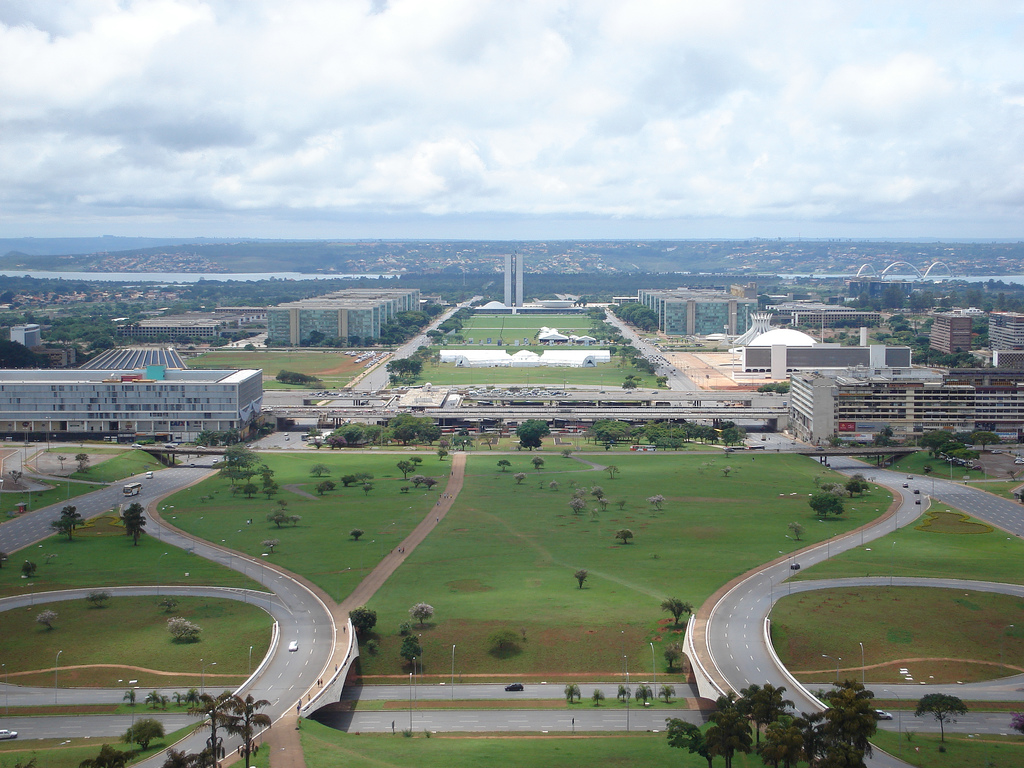
Design of Brasília - influenced by The Athens Charter
Art Deco
The Art Deco architectural style (called Style Moderne in France), was modern, but it was not modernist; it had many features of modernism, including the use of reinforced concrete, glass, steel, chrome, and it rejected traditional historical models, such as the Beaux-Arts style and Neo-classicism; but, unlike the modernist styles of Le Corbusier and Mies van der Rohe, it made lavish use of decoration and color. It reveled in the symbols of modernity; lightning flashes, sunrises, and zig-zags. Art Deco had begun in France before World War I and spread through Europe; in the 1920s and 1930s it became a highly popular style in the United States, South America, India, China, Australia and Japan. In Europe, Art Deco was particularly popular for department stores and movie theaters. The style reached its peak in Europe at the International Exhibition of Modern Decorative and Industrial Arts in 1925, which featured art deco pavilions and decoration from twenty countries. Only two pavilions were purely modernist; the Esprit Nouveau pavilion of Le Corbusier, which represented his idea for a mass-produced housing unit, and the pavilion of the USSR, by Konstantin Melnikov in a flamboyantly futurist style.
Later French landmarks in the Art Deco style included the Grand Rex movie theater in Paris, La Samaritaine department store by Henri Sauvage (1926–28) and the Social and Economic Council building in Paris (1937–38) by Auguste Perret, and the Palais de Tokyo and Palais de Chaillot, both built by collectives of architects for the 1937 Paris Exposition Internationale des Arts et Techniques dans la Vie Moderne.

La Samaritaine department store, by Henri Sauvage, Paris, (1925–28)
American Art Deco; the skyscraper style (1919-1932)
In the late 1920s and early 1930s, an exuberant American variant of Art Deco appeared in the Chrysler Building, Empire State Building and Rockefeller Center in New York Ciy, and Guardian Building in Detroit. The first skyscrapers in Chicago and New York had been designed in a neo-gothic or neoclassical style, but these buildings were very different; they combined modern materials and technology (stainless steel, concrete, aluminum, chrome-plated steel) with Art Deco geometry; stylized zig-zags, lightning flashes, fountains, sunrises, and, at the top of the Chrysler building, Art Deco "gargoyles" in the form of stainless steel radiator ornaments.

The American Radiator Building in New York City by Raymond Hood (1924)
The interiors of these new buildings, sometimes termed Cathedrals of Commerce", were lavishly decorated in bright contrasting colors, with geometric patterns variously influenced by Egyptian and Mayan pyramids, African textile patterns, and European cathedrals, Frank Lloyd Wright himself experimented with Mayan Revival, in the concrete cube-based Ennis House of 1924 in Los Angeles. The style appeared in the late 1920s and 1930s in all major American cities. The style was used most often in office buildings, but it also appeared in the enormous movie palaces that were built in large cities when sound films were introduced.

Crown of the General Electric Building
(also known as 570 Lexington Avenue) by Cross & Cross (1933)
The streamline style and Public Works Administration Architecture
The beginning of the Great Depression in 1929 brought an end to lavishly-decorated Art Deco architecture and a temporary halt to the construction of new skyscrapers. It also brought in a new style, called "Streamline Moderne" or sometimes just Streamline. This style, sometimes modeled after for the form of ocean liners, featured rounded corners, strong horizontal lines, and often nautical features, such as superstructures and steel railings. It was associated with modernity and especially with transportation; the style was often used for new airport terminals, train and bus stations, and for gas stations and diners built along the growing American highway system. In the 1930s the style was used not only in buildings, but in railroad locomotives, and even refrigerators and vacuum cleaners. It both borrowed from industrial design and influenced it.

The San Francisco Maritime Museum , originally was a public bath house (1936)
In the United States, the Great Depression led to a new style for government buildings, sometimes called PWA Moderne, for the Public Works Administration, which launched gigantic construction programs in the U.S. to stimulate employment. It was essentially classical architecture stripped of ornament, and was employed in state and federal buildings, from post offices to the largest office building in the world at that time, Pentagon (1941-43), begun just before the United States entered the Second World War.

Long Beach Main Post Office (1933–34)
American modernism - Frank Lloyd Wright, Rudolph Schindler, Richard Neutra (1919-1939)
During the 1920s and 1930s, Frank Lloyd Wright resolutely refused to associate himself with any architectural movements. He considered his architecture to be entirely unique and his own. Between 1916 and 1922, he broke away from his earlier prairie house style and worked instead on houses decorated with textured blocks of cement; this became known as his "Mayan style", after the pyramids of the ancient Mayan civilization. He experimented for a time with modular mass-produced housing.
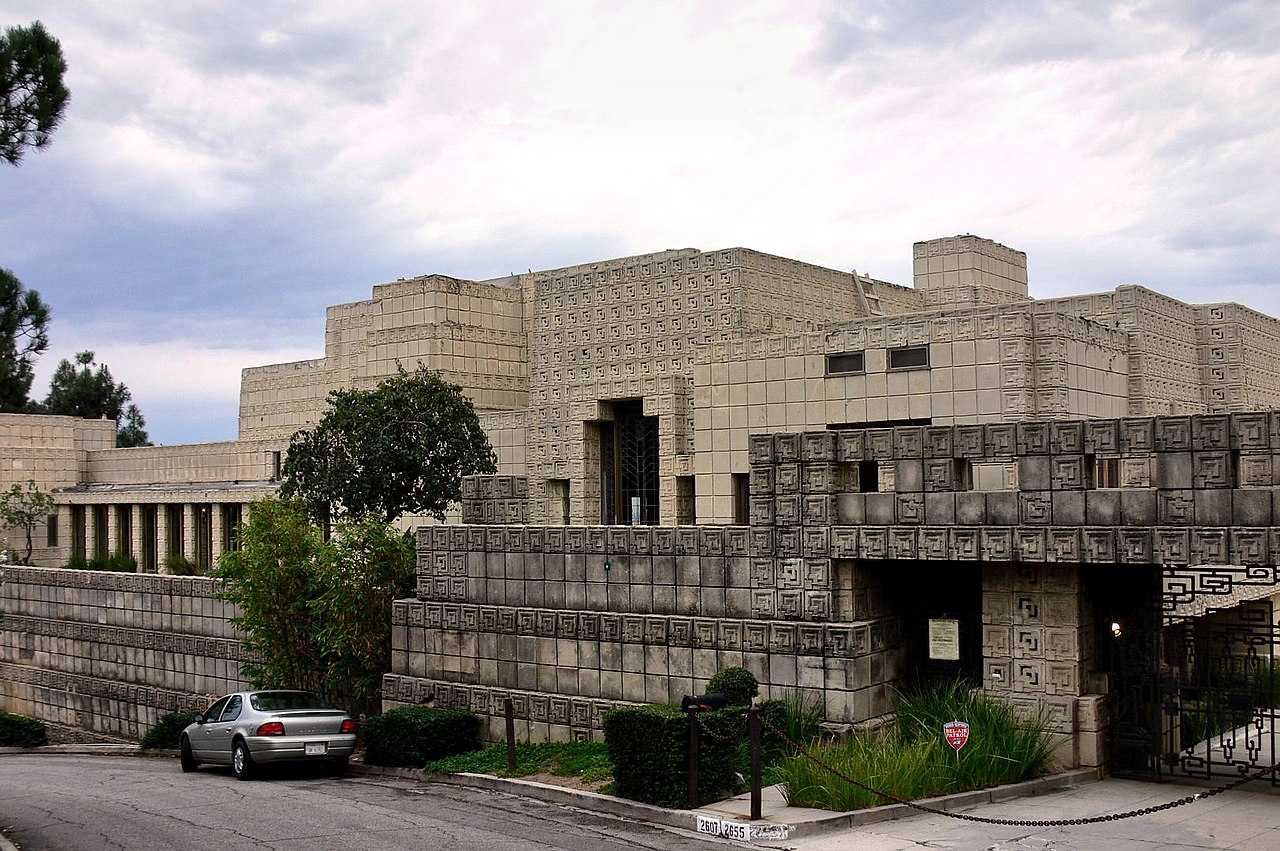
Ennis House in Los Angeles, by Frank Lloyd Wright (1924)
He identified his architecture as "Usonian", a combination of USA, "utopian" and "organic social order". His business was severely affected by the beginning of the Great Depression that began in 1929; he had fewer wealthy clients who wanted to experiment. Between 1928 and 1935, he built only two buildings: a hotel near Chandler, Arizona, and the most famous of all his residences, Fallingwater (1934-37), a vacation house in Pennsylvania for Edgar J. Kaufman. Fallingwater is a remarkable structure of concrete slabs suspended over a waterfall, perfectly uniting architecture and nature.

Fallingwater by Frank Lloyd Wright (1928–34)
The German architect Rudolph Schindler also contributed to American modernism with his design for the Lovell beach house in Newport Beach. The Austrian architect Richard Neutra moved to the United States in 1923, worked for short time with Frank Lloyd Wright, also quickly became a force in American architecture through his modernist design for the same client, the Lovell House in Los Angeles.

Lovell Beach House in Newport Beach by Rudolph Schindler (1926)
The Paris International Exposition of 1937 and the architecture of dictators
The 1937 Paris International Exposition in Paris effectively marked the end of the Art Deco, and of pre-war architectural styles. Most of the pavilions were in a neoclassical Deco style, with colonnades and sculptural decoration. The pavilions of Nazi Germany, designed by Albert Speer, in a German neoclassical style topped by eagle and swastika, faced the pavilion of the Soviet Union, topped by enormous statues of a worker and a peasant carrying a hammer and sickle. As to the modernists, Le Corbusier was practically, but not quite invisible at the Exposition; he participated in the Pavilion des temps nouveaux, but focused mainly on his painting. The one modernist who did attract attention was a collaborator of Le Corbusier, Josep Lluis Sert, the Spanish-Catalan architect, whose pavilion of the Second Spanish Republic was pure modernist glass and steel box. Inside it displayed the most modernist work of the Exposition, the painting Guernica by Pablo Picasso. The original building was destroyed after the Exposition, but it was recreated in 1992 in Barcelona.
The rise of nationalism in the 1930s was reflected in the Fascist architecture of Italy, and Nazi architecture of Germany, based on classical styles and designed to express power and grandeur. The Nazi architecture, much of it designed by Albert Speer, was intended to awe the spectators by its huge scale. Adolf Hitler intended to turn Berlin into the capital of Europe, more grand than Rome or Paris. The Nazis closed the Bauhaus, and the most prominent modern architects soon departed for Britain or the United States. In Italy, Benito Mussolini wished to present himself as the heir to the glory and empire of ancient Rome. Mussolini's government was not as hostile to modernism as The Nazis; the spirit of Italian Rationalism of the 1920s continued, with the work of architect Giuseppe Terragni His Casa dl Fascio in Como, headquarters of the local Fascist party, was a perfectly modernist building, with geometric proportions (33.2 meters long by 16.6 meters high); a clean facade of marble, and a Renaissance-inspired interior courtyard. Opposed to Terragni was Marcello Piacitini, a proponent of monumental fascist architecture, who rebuilt the University of Rome, and designed the Italian pavilion at the 1937 Paris Exposition, and planned a grand reconstruction of Rome on the fascist model.
The Pavilion of Nazi Germany (left) faced the Pavilion
of Stalin's Soviet Union (right) at the 1937 Paris Exposition.
The New York World's Fair (1939)
The 1939 New York World's Fair marked a turning point in architecture between the Art Deco and modern architecture. The theme of the Fair was the World of Tomorrow, and its symbols were the purely geometric trilon and perisphere sculpture. It had many monuments to Art Deco, such as the Ford Pavilion in the Streamline Moderne style, but also included the new International Style that would replace Art Deco as the dominant style after the War. The Pavilions of Finland, by Alvar Aalto, of Sweden by Sven Markelius, and of Brazil by Oscar Niemeyer and Lucio Costa, looked forward to a new style. They became leaders in the postwar modernist movement.
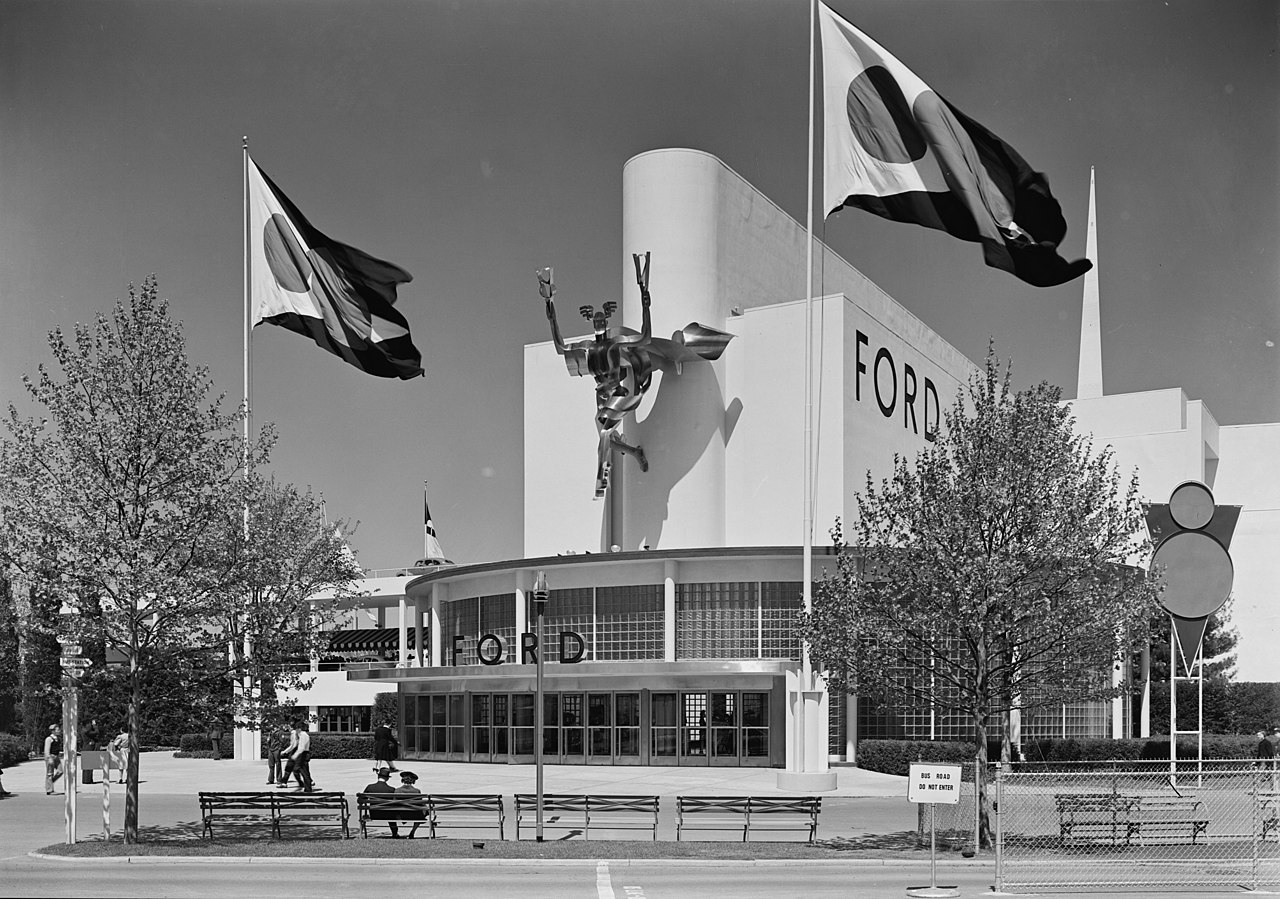
Pavilion of the Ford Motor Company, in the Streamline Moderne style
World War II - wartime innovation and postwar reconstruction (1939-1945)
World War II (1939-1945) and its aftermath was a major factor in driving innovation in building technology, and in turn, architectural possibilities. The wartime industrial demands resulted in shortages of steel and other building materials, leading to the adoption of new materials, such as aluminum, The war and postwar period brought greatly expanded use of prefabricated building; largely for the military and government. prefabricated building; the semi-circular metal Nissen hut of World War I revived as the Quonset hut. The years immediately after the war saw the development of radical experimental houses, including the enameled-steel Lustron house (1947-1950), and Buckminster Fuller's experimental aluminum Dymaxion House.
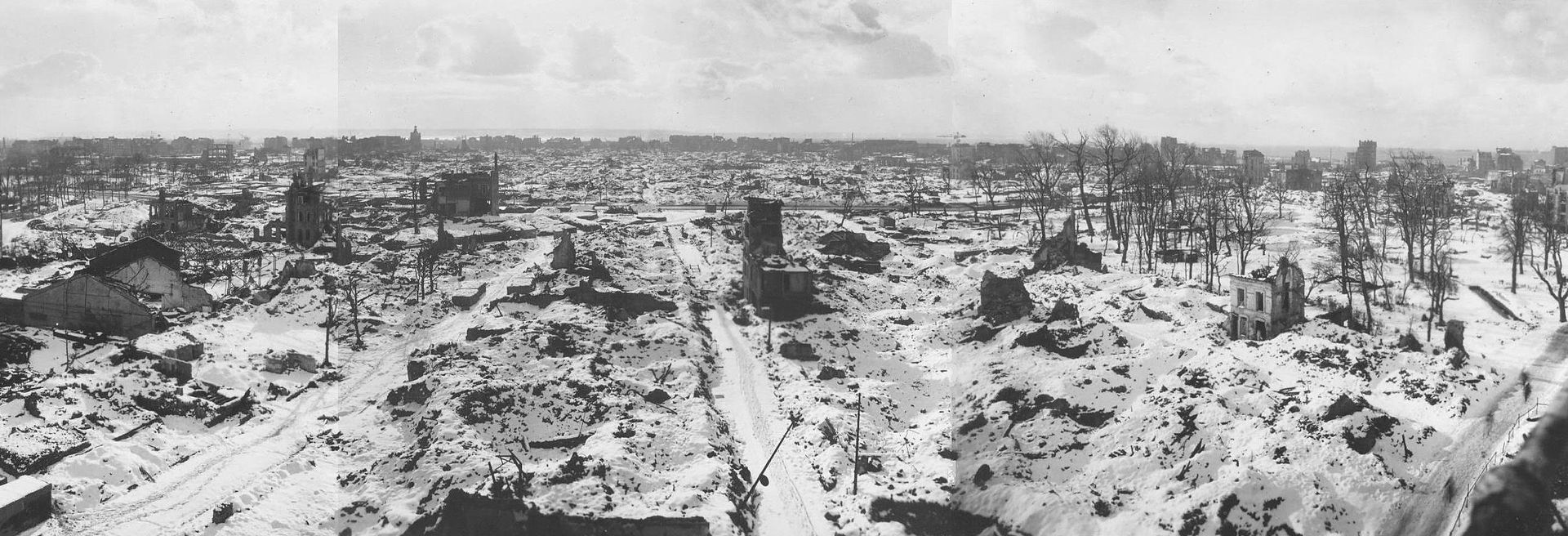
The center of Le Havre in winter 1943-44, destroyed by bombing
The unprecedented destruction caused by the war was another factor in the rise of modern architecture. Large parts of major cities, from Berlin, Tokyo and Dresden to Rotterdam and east London; all the port cities of France, particularly Le Havre, Brest, Marseille, Cherbourg had been destroyed by bombing. In the United States, little civilian construction had been done since the 1920s; housing was needed for millions of American soldiers returning from the war. The postwar housing shortages in Europe and the United States led to the design and construction of enormous government-financed housing projects, usually in run-down center of American cities, and in the suburbs of Paris and other European cities, where land was available,
One of the largest reconstruction projects was that of the city center of Le Havre, destroyed by the Germans and by Allied bombing in 1944; 133 hectares of buildings in the center were flattened, destroying 12,500 buildings and leaving 40,000 persons homeless. The architect Auguste Perret, a pioneer in the use of reinforced concrete and prefabricated materials, designed and built an entirely new center to the city, with apartment blocks, cultural, commercial and government buildings. He restored historic monuments when possible, and built a new church, St. Joseph, with a lighthouse-like tower in the center to inspire hope. His rebuilt city was declared a UNESCO World Heritage site in 2005.
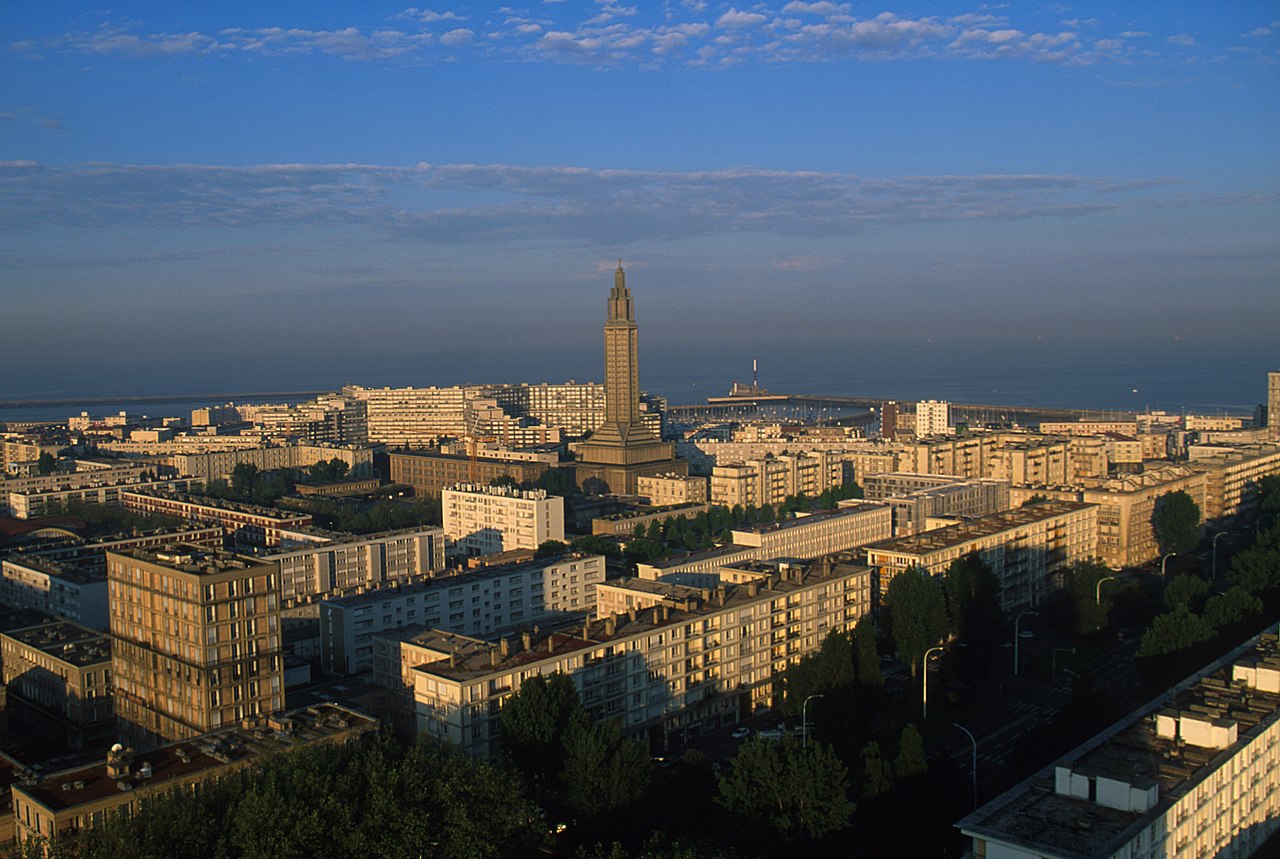
The center of Le Havre as reconstructed by August Perret (1946-1964)
Le Corbusier and the Cité Radieuse (1947-52)
Shortly after the War, the French architect Le Corbusier, who was nearly sixty years old and had not constructed a building in ten years, was commissioned by the French government to construct a new apartment block in Marseille. He called it Unité d'Habitation in Marseille, but it more popularly took the name of the Cité Radieuse, after his book about futuristic urban planning. Following his doctrines of design, the building had a concrete frame raised up above the street on pylons. it contained 337 duplex apartment units, fit into the framework like pieces of a puzzle. Each unit had two levels and a small terrace. Interior "streets" had shops, a nursery school and other serves, and the flat terrace roof had a running track, ventilation ducts, and a small theater. Le Corbusier designed furniture, carpets and lamps to go with the building, all purely functional; the only decoration was a choice of interior colors that Le Corbusier gave to residents. Unité d'Habitation became a prototype for similar buildings in other cities, both in France and Germany. Combined with his equally radical organic design for the Chapel of Notre-Dame du-Haut at Ronchamp, this work propelled Corbusier in the first rank of postwar modern architects.
Postwar modernism in the United States (1945-1985)
The international Style of architecture had appeared in Europe in the late 1920s and in 1932 it was recognized and given a name In 1932 at an Exhibition at the Museum of Modern Art in New York City organized by architect Philip Johnson and architectural critic Henry-Russell Hitchcock, but it was overshadowed by Art Deco and neoclassical styles. However, due to the rise of Hitler and the Nazis in Germany, between 1937 and 1941 most of the leaders of the German Bauhaus and New Objectivity movements found a new home in the United States. Each in its own way, the architects fleeing Germany redefined modern architecture and made it the dominant style in the United States.
Frank Lloyd Wright and the Guggenheim Museum
Frank Lloyd Wright was eighty years old in 1947; he had been present at the beginning of American modernism, and though he refused to accept that he belonged to any movement, continued to play a leading role almost to its end. One of his most original late projects was the campus of Florida Southern College in Lakeland, Florida, begun in 1941 and completed in 1943. He designed nine new buildings in a style that he described as "The Child of the Sun".

The Pfeiffer Chapel at Florida Southern College
by Frank Lloyd Wright (1941-1958)
He wrote that he wanted the campus to "grow out of the ground and into the light, a child of the sun." He completed several notable projects in the 1940s, including the Johnson Wax Headquarters and the Price Tower in Bartlesville, Oklahoma (1956). The building is unusual that it is supported by its central core of four elevator shafts; the rest of the building is cantilevered to this core, like the branches of a tree. Wright originally planned the structure for an apartment building in New York City. That project was cancelled because of the Great Depression, and he adapted the design for an oil pipeline and equipment company in Oklahoma. He wrote that in New York City his building would have been lost in a forest of tall buildings, but that in Oklahoma it stood alone. The design is asymmetrical; each side is different. In 1943 he was commissioned by the art collector Solomon R. Guggenheim to design a museum for his collection of modern art. His design was entirely original; a bowl-shaped building with a spiral ramp inside that led museum visitors on an upward tour of the art of the 20th century. Work began in 1946 but it was not completed until 1959, the year that he died.

Solomon Guggenheim Museum, by Frank Lloyd Wright (1946-1959)
Walter Gropius and Marcel Breuer
Walter Gropius, the founder of the Bauhaus, moved to England in 1934 and spent there years there before being invited to the United States by Walter Hudnut of the Harvard Graduate School of Design; Gropius became the head of the architecture faculty. Marcel Breuer, who had worked with him at the Bauhaus, joined him and opened an office in Cambridge. The fame of Gropius and Breuer attracted many students, who themselves became famous architects, including Ieoh Ming Pei and Philip Johnson.

Story Hall of the Harvard Graduate School of Design
by Walter Gropius and (The Architects Collaborative)
They did not receive an important commission until 1941, when they designed housing for workers in Kensington, Pennsylvania, near Pittsburgh., In 1945 Gropius and Breuer associated with a group of younger architects under the name TAC (The Architects Collaborative). Their notable works included the building of the Harvard Graduate School of Design, the U.S. Embassy in Athens (1956-57), and the headquarters of Pan American Airways in New York (1958-63).

The Stillman House Litchfield, Connecticut, by Marcel Breuer (1950)
The swimming pool mural is by Alexander Calder
Mies van der Rohe
Ludwig Mies van der Rohe described his architecture with the famous saying, "Less is more". As the director of the school of architecture of what is now called the Illinois Institute of Technology from 1939 to 1956, Mies (as he was commonly known) made Chicago the leading city for American modernism in the postwar years. He constructed new buildings for the Institute in modernist style, two high-rise apartment buildings on Lakeshore Drive (1948-51), which became models for high-rises across the country.

The Seagram Building, New York City, 1958,
by Ludwig Mies van der Rohe
Other major works included Farnsworth House in Plano, Illinois (1945-1951), a simple horizontal glass box that had an enormous influence on American residential architecture. The Chicago Convention Center (1952-54) and Crown Hall at the Illinois Institute of Technology (1950-56), and The Seagram Building in New York City (1954-58) also set a new standard for purity and elegance. Based on granite pillars, the smooth glass and steel walls were given a touch of color by the use of bronze-toned I-beams in the structure. He returned to Germany in 1962-68 to build the new Nationalgallerie in Berlin. His students and followers included Philip Johnson, and Eero Saarinen, whose work was substantially influenced by his ideas.

Lakeshore Drive Apartments, Chicago, (1948–51)
Richard Neutra and Charles Eames
Influential residential architects in the new style in the United States included Richard Neutra and Charles and Ray Eames. The most celebrated work of the Eames was Eames House in Pacific Palisades, California, (1949) Charles Eames in collaboration with Eero Saarinen It is composed of two structures, an architects residence and his studio, joined in the form of an L. The house, influenced by Japanese architecture, is made of translucent and transparent panels organized in simple volumes, often using natural materials, supported on a steel framework. The frame of the house was assembled in sixteen hours by five workmen. He brightened up his buildings with panels of pure colors.

Eames House by Charles and Ray Eames, Pacific Palisades, (1949)
Richard Neutra continued to build influential houses in Los Angeles, using the theme of the simple box. Many of these houses erased the line distinction between indoor and outdoor spaces with walls of plate glass. Neutra's Constance Perkins House in Pasadena, California (1962) was re-examination of the modest single-family dwelling. It was built of inexpensive material-wood, plaster, and glass-and completed at a cost of just under $18,000. Neutra scaled the house to the physical dimensions of its owner, a small woman. It features a reflecting pool which meanders under of the glass walls of the house. One of Neutra's most unusual buildings was Shepherd's Grove in Garden Grove, California, which featured an adjoining parking lot where worshippers could follow the service without leaving their cars.

The Constance Perkins House by Richard Neutra, Los Angeles (1962)
Skidmore, Owings and Merrill and Wallace K. Harrison
Many of the notable modern buildings in the postwar years were produced by two architectural mega-agencies, which brought together large teams of designers for very complex projects. The firm of Skidmore, Owings & Merrill was founded in Chicago in 1936 by Louis Skidmore and Nathaniel Owings, and joined in 1939 by engineer John Merrill, It soon went under the name of SOM. Its first big project was Oak Ridge National Laboratory in Oak Ridge, Tennessee, the gigantic government installation that produced plutonium for the first nuclear weapons.
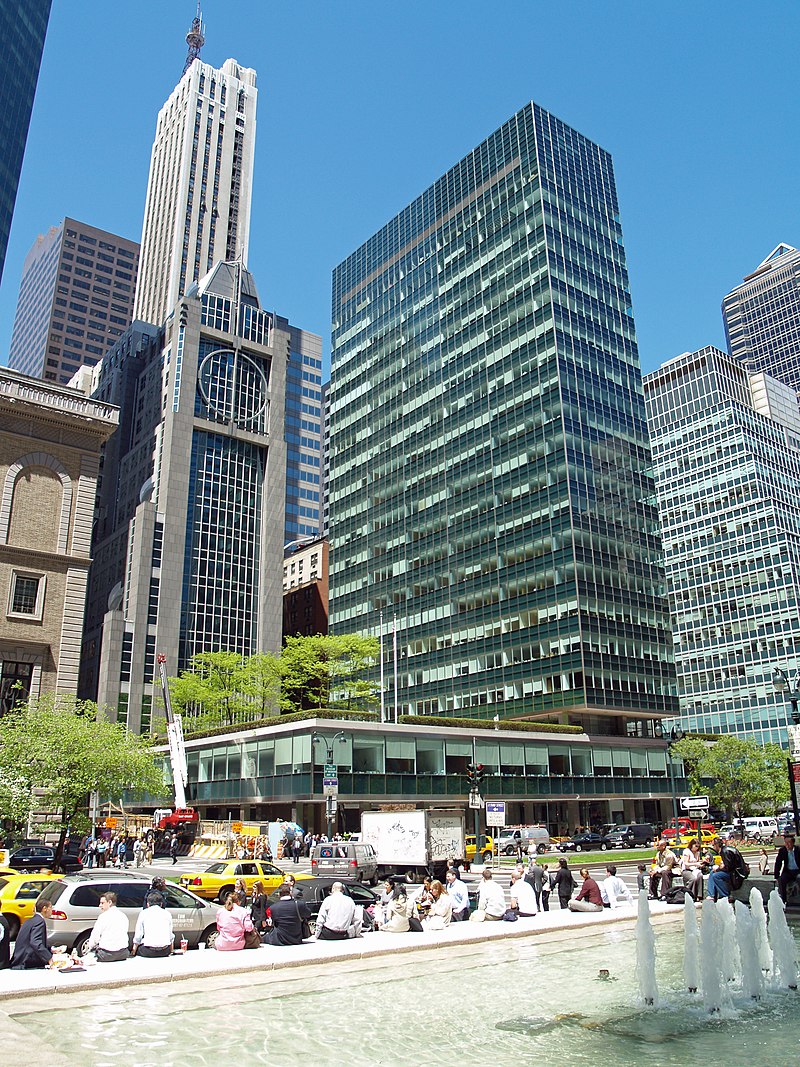
Lever House by Skidmore, Owings & Merrill (1951–52)
In 1964 the firm had eighteen "partner-owners", 54 "associate participants,"and 750 architects, technicians, designers, decorators, and landscape architects. Their style was largely inspired by the work of Ludwig Mies van der Rohe, and their buildings soon had a large place in the New York skyline, including the Lever House (1951-52) and the Manufacturers Trust Company Building (1954). Later buildings by the firm include Beinecke Library at Yale University (1963), the Willis Tower, formerly Sears Tower in Chicago (1973) and One World Trade Center in New York City (2013), which replaced the building (destroyed in the terrorist attack of September 11. 2001.

Manufacturers Trust Company Building ,
by Skidmore, Owings & Merrill, New York City (1954)
Wallace Harrison played a major part in the modern architectural history of New York; as the architectural advisor of the Rockefeller Family, he helped design Rockefeller Center, the major Art Deco architectural project of the 1930s. He was supervising architect for the 1939 New York World's Fair, and, with his partner Max Abramowitz, was the builder and chief architect of the United Nations Building; Harrison headed a committee of international architects, which included Oscar Niemeyer (who produced the original plan approved by the committee) and Le Corbusier, Other landmark New York buildings designed by Harrison and his firm included Metropolitan Opera House, the master plan for Lincoln Center, and John F. Kennedy Airport.

United Nations Headquarters in New York,
by Wallace Harrison with Oscar Niemeyer and Le Corbusier (1952)
Philip Johnson
Philip Johnson (1906-2005) was one of the youngest and last major figures in American modern architecture. He trained at Harvard with Walter Gropius, then was director of the department of architecture and modern design at the Metropolitan Museum of Art from 1946 to 1954.

The IDS Center in Minneapolis, Minnesota, by Philip Johnson (1969–72)
In 1947, he published a book about Mies van der Rohe, and in 1953 designed his own residence, the Glass House in New Canaan, Connecticut in a style modeled after Mies's Farnsworth House. Beginning in 1955 he began to go in his own direction, moving gradually toward expressionism with designs that increasingly departed from the orthodoxies of modern architecture.

The Crystal Cathedral by Philip Johnson (1977–80)
His final and decisive break with modern architecture was the AT&T Building (later known as the Sony Tower, and now the 550 Madison Avenue in New York City, (1979) an essentially modernist skyscraper completely altered by the addition of curved cap at the top of a piece of chippendale furniture. This building is generally considered to mark the beginning of Postmodern architecture in the United States.
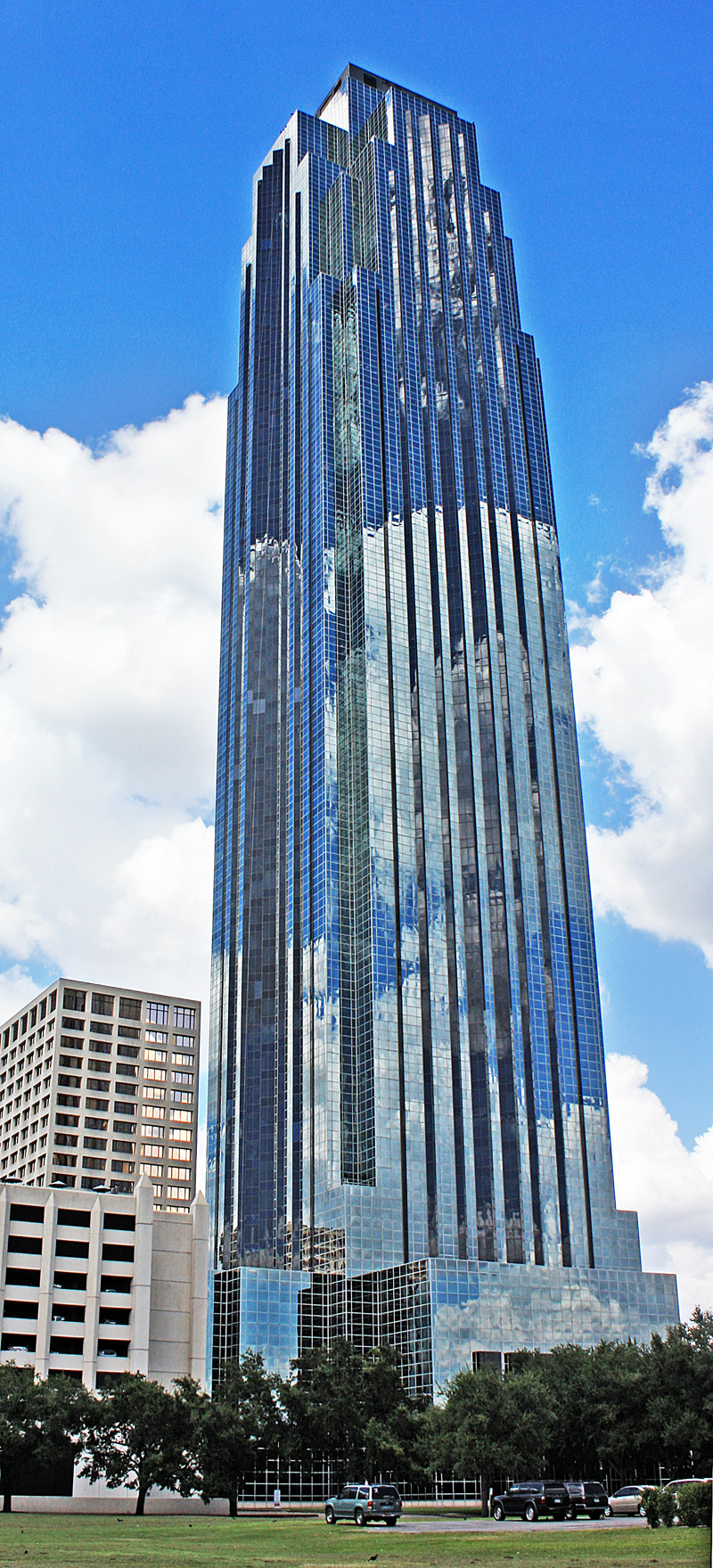
The Williams Tower in Houston, Texas, by Philip Johnson (1981–1983)
Eero Saarinen
Eero Saarinen (1910-1961) was the son of Eliel Saarinen, the most famous Finnish architect of the Art Nouveau period, who emigrated to the United States in 1923, when Eero was thirteen. He studied art and sculpture at the academy where his father taught, and then at the Académie de la Grande Chaumière Academy in Paris before studying architecture at Yale University.

The Gateway Arch in Saint Louis, Missouri (1948–1965)
His architectural designs were more like enormous pieces of sculpture than traditional modern buildings; he broke away from the elegant boxes inspired by Mies van der Rohe and used instead sweeping curves and parabolas, like the wings of birds. In 1948 he conceived the idea of a monument in St. Louis, Missouri in the form of a parabolic arch 192 meters high, made of stainless steel (1948).

Main building of the General Motors Technical Center (1949–55)
He then designed the General Motors Technical Center in Warren, Michigan (1949-55), a glass modernist box in the style of Mies van der Rohe, followed by the IBM Research Center in Yorktown, Virginia (1957-61). His next works were a major departure in style; he produced a particularly striking sculptural design for the Ingalls Rink in New Haven, Connecticut (1956-59, an ice skiing rink with a parabolic roof suspended from cables, which served as a preliminary model for next and most famous work, the TWA Terminal at JFK airport in New York (1956-1962).

The TWA Terminal at JFK Airport in New York, by Eero Saarinen (1956–62)
His declared intention was to design a building that was distinctive and memorable, and also one that would capture the particular excitement of passengers before a journey. The structure is separated into four white concrete parabolic vaults, which together resemble a bird on the ground perched for flight. Each of the four curving roof vaults has two sides attached to columns in a Y form just outside the structure. One of the angles of each shell is lightly raised, and the other is attached to the center of the structure. The roof is connected with the ground by curtain walls of glass. All of the details inside the building, including the benches, counters, escalators and clocks, were designed in the same style.
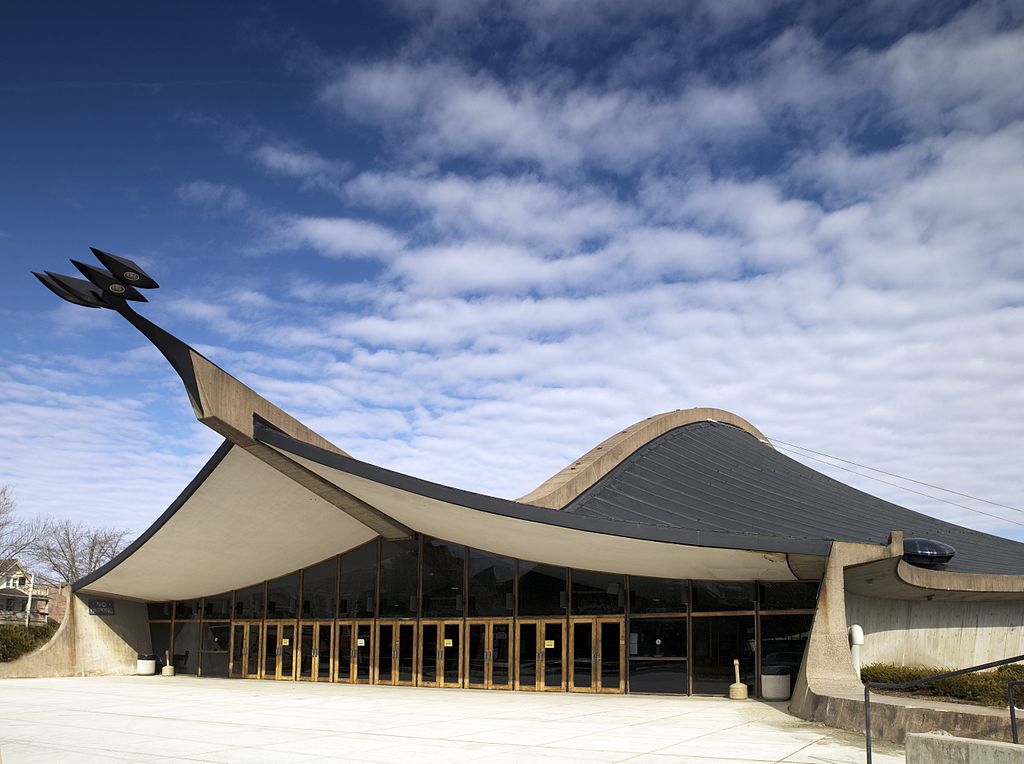
The Ingalls Rink in New Haven, Connecticut (1953–58)
Louis Kahn
Louis Kahn (1901-74) was another American architect who moved away from the Mies van der Rohe model of the glass box, and other dogmas of the prevailing international style. He borrowed from a wide variety of styles, and idioms, including neoclassicism. He was professor of architecture at Yale University from 1947-57, where his students included Eero Saarinen.
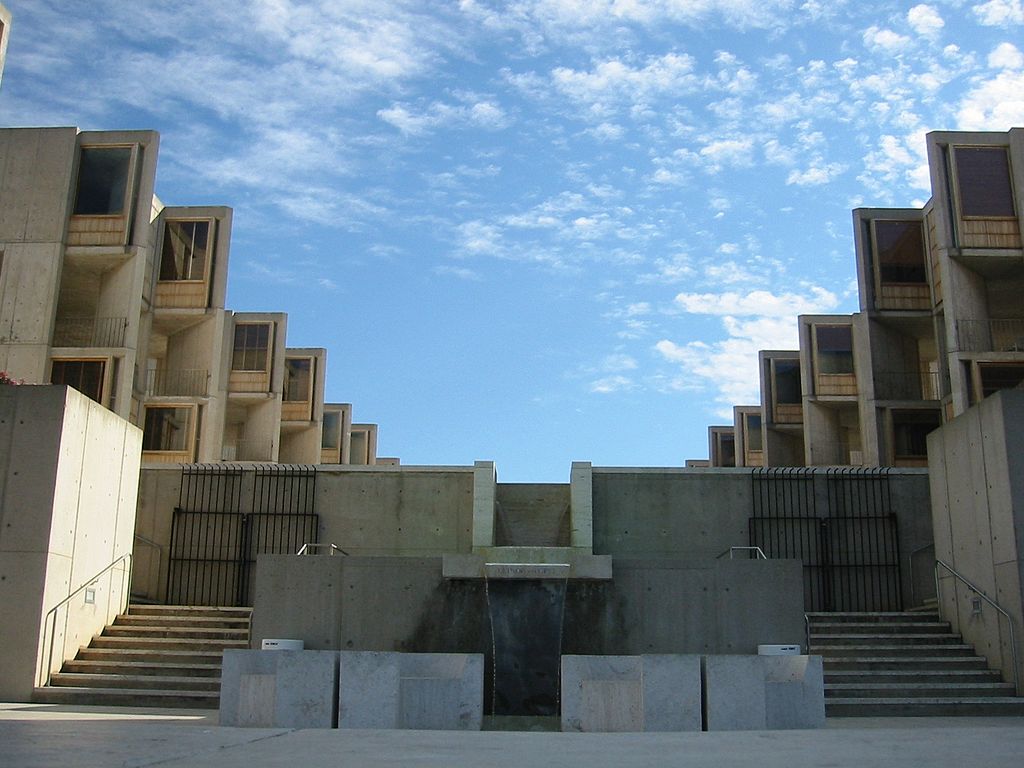
The Salk Institute by Louis Kahn (1962–63)
From 1957 until his death he was professor of architecture at the University of Pennsylvania. His work and ideas influenced Philip Johnson, Minoru Yamasaki, and Edward Durell Stone as they moved toward a more neoclassical style. Unlike Mies, he did not try to make his buildings look light; he constructed mainly with concrete and brick, and made his buildings look monumental and solid.

Richards Medical Research Laboratories by Louis Kahn (1957–61)
He drew from a wide variety of different sources; the towers of Richards Medical Research Laboratories were inspired by the architecture of the Renaissance towns he had seen in Italy as a resident architect at the American Academy in Rome in 1950. Notable buildings by Kahn in the United States include the First Unitarian Church of Rochester, New York (1962);

The Kimball Art Museum in Fort Worth, Texas (1966–72)
and the Kimball Art Museum in Fort Worth, Texas (1966-72). Following the example of Le Corbusier and his design of the government buildings in Chandigarh, the capital city of the Haryana & Punjab State of India, Kahn designed the Jatiyo Sangshad Bhaban (National

The First Unitarian Church of Rochester by Louis Kahn (1962)
Assembly Building) in Dhaka, Bangladesh (1962-74), when that country won independence from Pakistan. It was Kahn's last work.

The:National Parliament Building in Dhaka, Bangladesh (1962–74)
Ieoh Ming Pei
Ieoh Ming Pei (1917- ) was a major figure in late modernism and the debut of Post-modern architecture. He was born in China and educated in the United States, studying architecture at the Massachusetts Institute of Technology. While the architecture school there still trained in the Beaux-Arts architecture style, Pei discovered the writings of Le Corbusier, and a two-day visit by Le Corbusier to the campus in 1935 had a major impact on Pei's ideas of architecture. In the late 1930s he moved to the Harvard Graduate School of Design, where he studied with Walter Gropius and Marcel Breuer and became deeply involved in Modernism.

Green Building at the Massachusetts Institute
of Technology by I.M. Pei (1962–64)
After the War he worked on large projects for the New York real estate developer William Zeckendorf, before breaking away and starting his own firm. One of the first buildings his own firm designed was the Green Building at the Massachusetts Institute of Technology. While the clean modernist facade was admired, the building developed an unexpected problem; it created a wind-tunnel effect, and in strong winds the doors could not be opened. Pei was forced to construct a tunnel so visitors could enter the building during high winds.

The National Center for Atmospheric Research in Boulder,
Colorado by I.M. Pei (1963-67)
Between 1963 and 1967 Pei designed the Mesa Laboratory for the National Center for Atmospheric Research outside Boulder, Colorado, in an open area at the foothills of the Rocky Mountains. The project differed from Pei's earlier urban work; it would rest in an open area in the foothills of the Rocky Mountains. His design was a striking departure from traditional modernism; it looked as if it were carved out of the side of the mountain.
In the late modernist area, art museums bypassed skyscrapers as the most prestigious architectural projects; they offered greater possibilities for innovation in form and more visibility. Pei established himself with his design for the Herbert F. Johnson Museum of Art at Cornell University in Ithaca, New York (1973), which was praised for its imaginative use of a small space, and its respect for the landscape and other buildings around it.

East Wing of the National Gallery of Art in Washington, D.C., by I M. Pei (1978)
This led to the commission for one of the most important museum projects of the period, the new East Wing of the National Gallery of Art in Washington, completed in 1978, and to another of Pei's most famous projects, the pyramid at the entrance of Louvre Museum in Paris (1983–89). Pei chose the pyramid as the form that best harmonized with the Renaissance and neoclassical forms of the historic Louvre., as well as for its associations with Napoleon and the Battle of the Pyramids. Each face of the pyramid is supported by 128 beams of stainless steel, supporting 675 panels of glass, each 2.9 by 1.9 meters.

Pyramid of the Louvre Museum in Paris by I.M. Pei (1983–89)
Postwar modernism in Europe (1945-1975)
In France, Le Corbusier remained the most prominent architect, though he built few buildings there. His most prominent late work was the convent of Sainte Marie de La Tourette in Evreaux-sur-l'Arbresle. The Convent, built of raw concrete, was austere and without ornament, inspired by the medieval monasteries he had visited on his first trip to Italy.

Sainte Marie de La Tourette in Evreaux-sur-l'Arbresle, France by Le Corbusier (1956–60)
In Britain, the major figures in modernism included James Stirling (1926-1992) and Denys Lasdun (1914-2001). Lasdun's best-known work is the Royal National Theatre (1967-1976) on the south bank of the Thames. Its raw concrete and blockish form offended British traditionalists; Charles, Prince of Wales Prince Charles compared it with a nuclear power station.
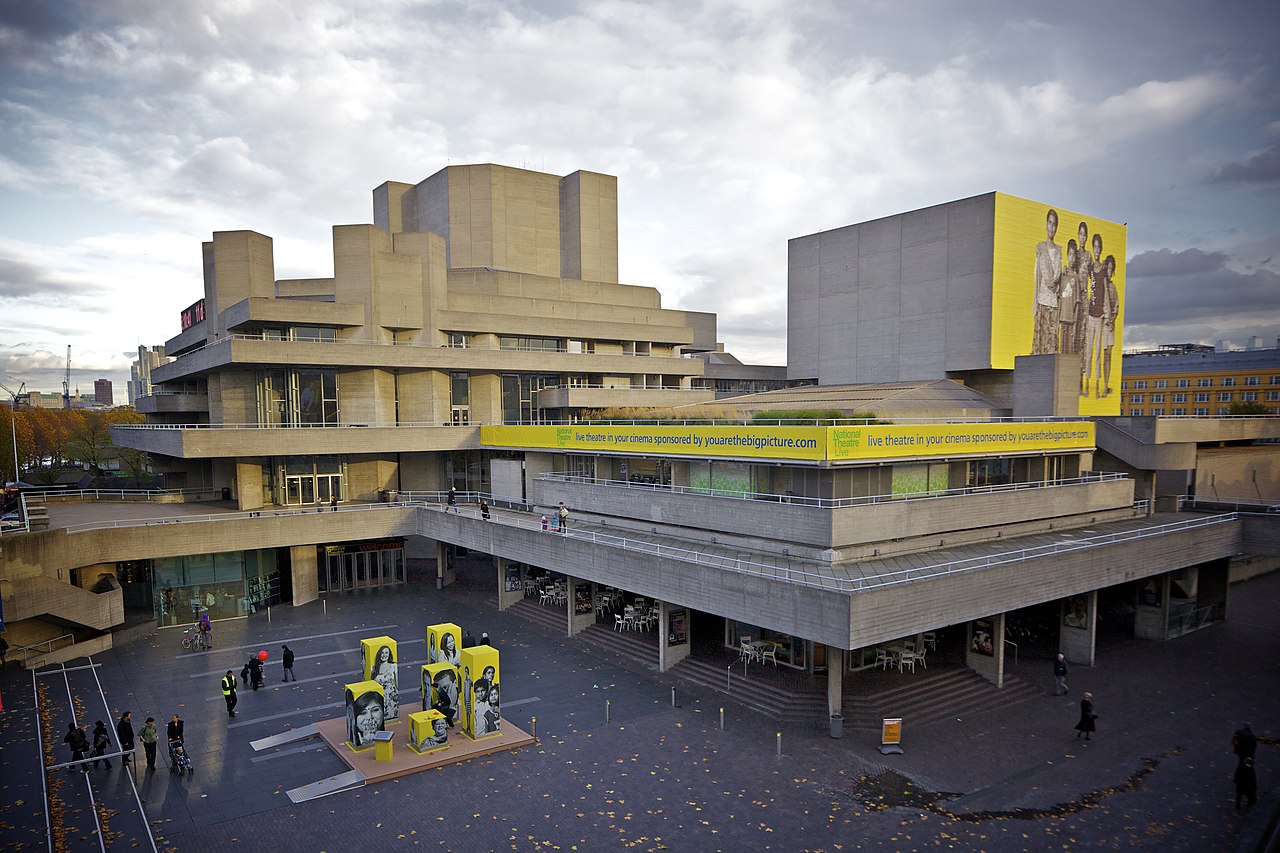
Royal National Theatre, London, by Denys Lasdun (1967-1976)
In Belgium, a major figure was Charles Vandenhove (born 1927) who constructed an important series of buildings for the University Hospital Center in Liege. His later work ventured into colorful rethinking of historical styles, such as Palladian architecture.

University Hospital Center in Liege, Belgium by Charles Vandenhove (1962–82)
In Finland, the most influential architect was Alvar Aalto, who adapted his version of modernism to the Nordic landscape, light, and materials, particularly the use of wood., After World War II, he taught architecture in the United States. In Sweden, Arne Jacobsen was the best-known of the modernists, who designed furniture as well as carefully-proportioned buildings.

Auditorium of the University of Technology, Helsinki, by Alvar Aalto (1964)
In Italy, the most prominent modernist was Gio Ponti, who worked often with the structural engineer Pier Luigi Nervi, a specialist in reinforced concrete. Nervi created concrete beams of exceptional length, twenty-five meters, which allowed greater flexibility in forms and greater heights. Their best-known design was the Pirelli Building in Milan (1958-1960), which for decades was the tallest building in Italy.

The Pirelli Tower in Milan, by Gio Ponti
and Pier Luigi Nervi(1958–60)
The most famous Spanish modernist was the Catalan architect Josep Lluis Sert , who worked with great success in Spain, France and the United States. In his early carer he worked for a time under Le Corbusier, and designed the Spanish pavilion for the 1937 Paris Exposition. His notable later work included the Fondation Maeght in Saint-Paul-de-Provence, France (1964), and the Harvard Science Center in Cambridge, Massachusetts. He served as Dean of Architecture at the Harvard School of Design.

The Fondation Maeght by Josep Lluis Sert (1959-1964)
Notable German modernists included Johannes Krahn, who played an important part in rebuilding German cities after World War II, and built several important museums and churches, notably St. Martin, Idstein, which artfully combined stone masonry, concrete and glass. Leading Austrian architects of the style included Gustav Peichl, whose later works included the Art and Exhibition Center of the German Federal Republic in Bonn, Germany (1989).

Warszawa Centralna railway station in Poland by Arseniusz Romanowicz (1975)
Latin America
Brazil became a showcase of modern architecture in the late 1930s through the work of Lucio Costa (1902-1998) and Oscar Niemeyer (1907-2012). Costa had the lead and Niemeyer collaborated on the Ministry of Education and Health in Rio de Janeiro (1936-43) and the Brazilian pavilion at the 1939 World's Fair in New York. Following the war, Niemeyer, along with Le Corbusier, conceived the form of the United Nations Headquarters constructed by Walter Harrison.

Ministry of Health and Education in Rio de Janeiro by Lucio Costa (1936–43)
Lucio Costa also had overall responsibility for the plan of the most audacious modernist project in Brazil; the creation of a new capital, Brasilia, constructed between 1956 and 1961. Costa made the general plan, laid out in the form of a cross, with the major government buildings in the center. Niemeyer was responsible for designing the government buildings, including the palace of the President; the National Assembly, composed of two towers for the two branches of the legislature and two meeting halls, one with a cupola and other with an inverted cupola. Niemeyer also built the cathedral, eighteen ministries, and giant blocks of housing, each designed for three thousand residents, each with its own school, shops, and chapel.

MAM Rio museum, by Affonso Eduardo Reidy (1960)
Following a military coup d'état in Brazil in 1964, Niemeyer moved to France, where he designed the modernist headquarters of the French Communist Party in Paris (1965-1980), a miniature of his United Nations plan.
Mexico also had a prominent modernist movement. Important figures included Félix Candela, born in Spain, who emigrated to Mexico in 1939, and participated in the construction of the new University of Mexico City; he specialized in concrete structures in unusual parabolic forms. Another important figure was Mario Pani, who designed the National Conservatory of Music in Mexico City (1949), and the Torre Insignia (1988).

The Torre Latinoamericana in Mexico City by Augusto H. Alvarez (1956)
Augusto H. Alvarez designed the Torre Latinamericano, one of the early modernist skyscrapers in Mexico City (1956); it successfully withstood the 1985 Mexico City earthquake, which destroyed many other buildings in the city center. 1964. Pedro Ramirez Vasquez and Rafael Mijares designed the Olympic Stadium for the 1968 Olympics, and Antoni Peyri and Candela designed the Palace of Sports.

The Palácio do Planalto, seat of the Brazilian government,
by Oscar Niemeyer (1958–60)
Luis Barragan was another influential figure in Mexican modernism; his raw concrete residence and studio in Mexico City looks like a blockhouse on the outside, while inside it features great simplicity in form, pure colors, abundant natural light, and, one of is signatures, a stairway without a railing. He won the Pritzker Architecture Prize in 1980, and the house was declared UNESCO World Heritage Site in 2004.
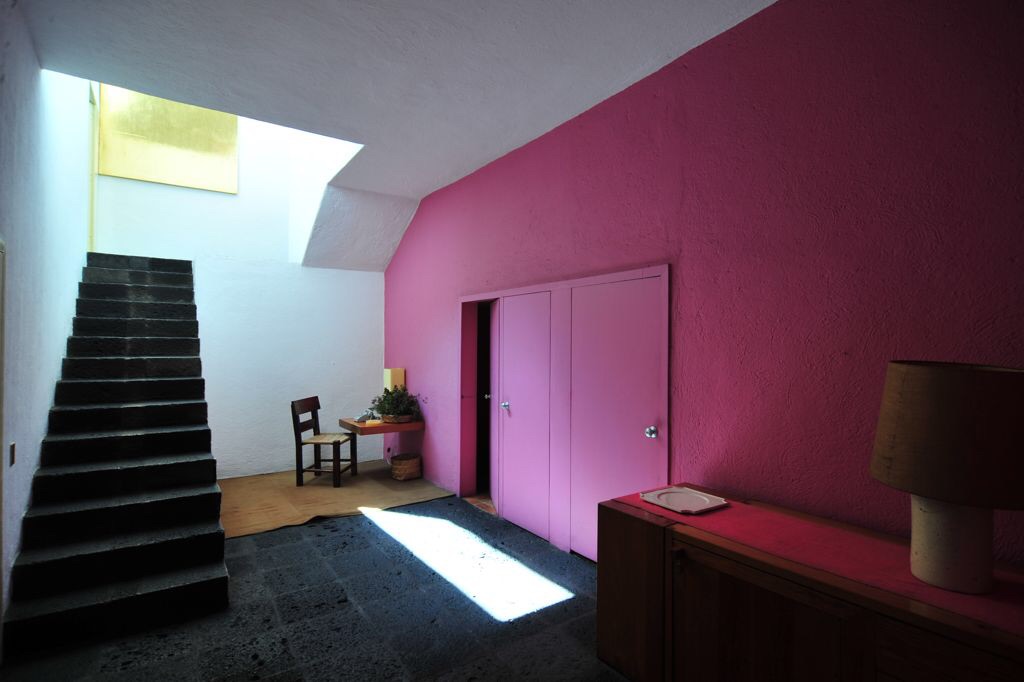
Interior of the Luis Barragán House and Studio in Mexico City, by Luis Barragan (1948)
Asia and the Pacific
Japan, like Europe, had an enormous shortage of housing after the war, due to the bombing of many cities. 4.2 million housing units needed to be replaced. Japanese architects combined both traditional and styles and techniques. One of the foremost Japanese modernists was Kunio Maekawa (1905-1986), who had worked for Le Corbusier in Paris until 1930. His own house in Tokyo was an early landmark of Japanese modernism, combining traditional style with ideas he acquired working with Le Corbusier. His notable buildings include concert halls in Tokyo and Kyoto and the International House of Japan in Tokyo, all in the pure modernist style.

International House of Japan by Kunio Maekawa, Tokyo (1955)
Kenzo Tange (1913-2005) worked in the studio of Kunio Maekawa from 1938 until 1945 before opening his own architectural firm. His first major commission was the Hiroshima Peace Memorial Museum. He designed many notable office buildings and cultural centers. office buildings, as well as the Yoyogi National Gymnasium for the 1964 Summer Olympics in Tokyo. The gymasim, built of concrete, features a roof suspended over the stadium on steel cables.

Yoyogi National Gymnasium by Kenzo Tange (1964)
The Danish architect Jorn Utzon (1918-) worked briefly with Alvar Aalto, studied the work of Le Corbusier, and traveled to the United States to meet Frank Lloyd Wright. In 1957 he designed one of the most recognizable modernist buildings in the world; the Sydney Opera House.. He is known for the sculptural qualities of his buildings, and their relationship with the landscape. The five concrete shells of the structure resemble seashells by the beach. Begun in 1957, the project encountered considerable technical difficulties making the shells and getting the acoustics right. Utzon resigned in 1966, and the opera house was not finished until 1973, ten years after its scheduled completion.

Sydney Opera House in Sydney, Australia, by Jorn Utzon (1973)
From modernism to high-tech and postmodernism (1970-2000)
Beginning in the late 1960s, the international style was increasingly challenged by critics and architects who wanted architecture to have more imaginative and expressive forms, not always strictly attached to function. There was no single new style; some new buildings were in a high-tech style, exploring new and original materials. Others were neoclassical, with elements of historic regional architectural styles; and others were astonishing gigantic works of glass, steel and concrete sculpture, pushing to the limits the possibilities of building technology. Very often, new museums and concert halls were the most dramatic examples of the new styles.
Among the most striking examples of high-tech architecture is the Centre Georges Pompidou, the museum of modern art in Paris (1971-1977), A jury of distinguished architects, including Philip Johnson and Oscar Niemeyer, reviewed 681 different proposals and chose one by two relatively-unknown architects, Renzo Piano and Richard Rogers. The museum resembles an enormous machine. It in reality has two structures; a reinforced concrete interior structure, and on the exterior another structure of steel and glass, where all the functional working of the buildings, from air conditioning ducts to escalators, are clearly visible. Rogers followed the Pompidou Center with the Lloyds Building in Central London (1978–86), a twenty-story office building which steel structure which resembles an industrial building assembled from a kit of metal and glass parts.

The Lloyds building in London,
by Richard Rogers (1978-1986)
The British architect Norman Foster was another important innovator in high-tech architecture. His HSBC Building in Hong Kong, a 78-meter tall office tower, was prefabricated in Britain in the form of five modules, made of 30,000 tons of steel and 4,500 tons of aluminium, which were assembled like pieces from a kit in Hong Kong. While it was high-tech on form, it also followed the traditional Chinese principles of Feng Shui.

The HSBC Building in Hong Kong,
by Norman Foster (1979-1985)
The movement of postmodern architecture had the opposite goal from that of high-tech architecture; its intent was to bring back the traditions and decorative elements of past styles. The term was first used by American architectural historian Charles Jencks in 1975, and then became the title of his 1977 book The Language of Post-Modern Architecture. In his book he declared that modern architecture had died precisely at 3:32 in the afternoon of July 15, 1972, when an aging complex of high-rise public housing buildings in Saint Louis, Missouri, designed and built following the modernist precepts of Le Corbusier, was dynamited and torn down. He called for a return to eclecticism, variety and ornament.
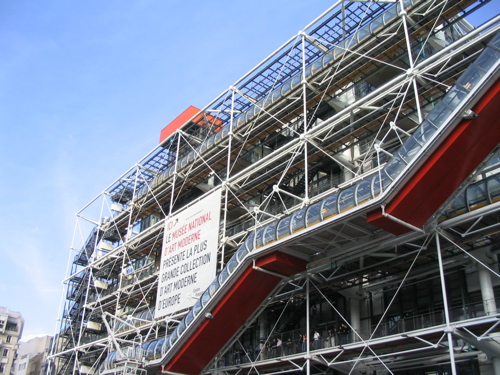
Centre Georges Pompidou, Paris,
by Renzo Piano and Richard Rogers (1971-1977)
Another important advocate of postmodernism was Robert Venturi, in his book Complexity and Contradiction in Architecture (1966) and particularly in his book Learning from Las Vegas (co-authored with Denise Scott-Brown and Steven Izenour, 1972), in which he celebrated the neon advertising signs and flamboyant casino architecture of Las Vegas, Nevada. He denied the principle of Mies van der Rohe that "Less is More", and called for a return to complexity and ornament. Venturi created a variety of buildings to illustrate his ideas, notably the Guild House in Philadelphia, with subtle classical elements.

The Piazza d'Italia in New Orleans, Louisiana by Charles Moore (1974–78)
Philip Johnson, who had first taken his inspiration from Le Corbusier, also began to look beyond modernism for something new. His AT&T Building (now 550 Madison Avenue) in New York, a modernist office tower with a neoclassical Chippendale pediment on top, like a piece of 18th century furniture, became an icon of post-modernism. Charles Moore created the exuberant Piazza d'Italia in New Orleans, Louisiana, a public square filled with recreated pieces of Italian renaissance architecture. Other notable postmodernists included Michael Graves, with his pioneering Portland Building in Portland, Oregon and the Denver Public Library.

The AT&T Building (now 550 Madison Avenue),
New York City, by Philip Johnson (1979–84)
Several influential architects at the end of the 20th century are difficult to put into any one category or movement. The notable end-of-century buildings of Richard Meier include the Getty Center in Los Angeles (1984-1997), where buildings of different shapes are united by their whitish stone-faced facades and broad panels of glass; and the High Museum of Art in Atlanta (1980-83).

The Getty Center in Los Angeles by Richard Meier (1984–97)
The California architect Frank Gehry created the Guggenheim Museum in Bilbao, Spain (1991-1997) as an enormous work of stainless steel sculpture, entirely detached from its environment and from any historical style. His Walt Disney Concert Hall in Los Angeles is also a vast work of metal sculpture, resembling the sails of ship at sea.
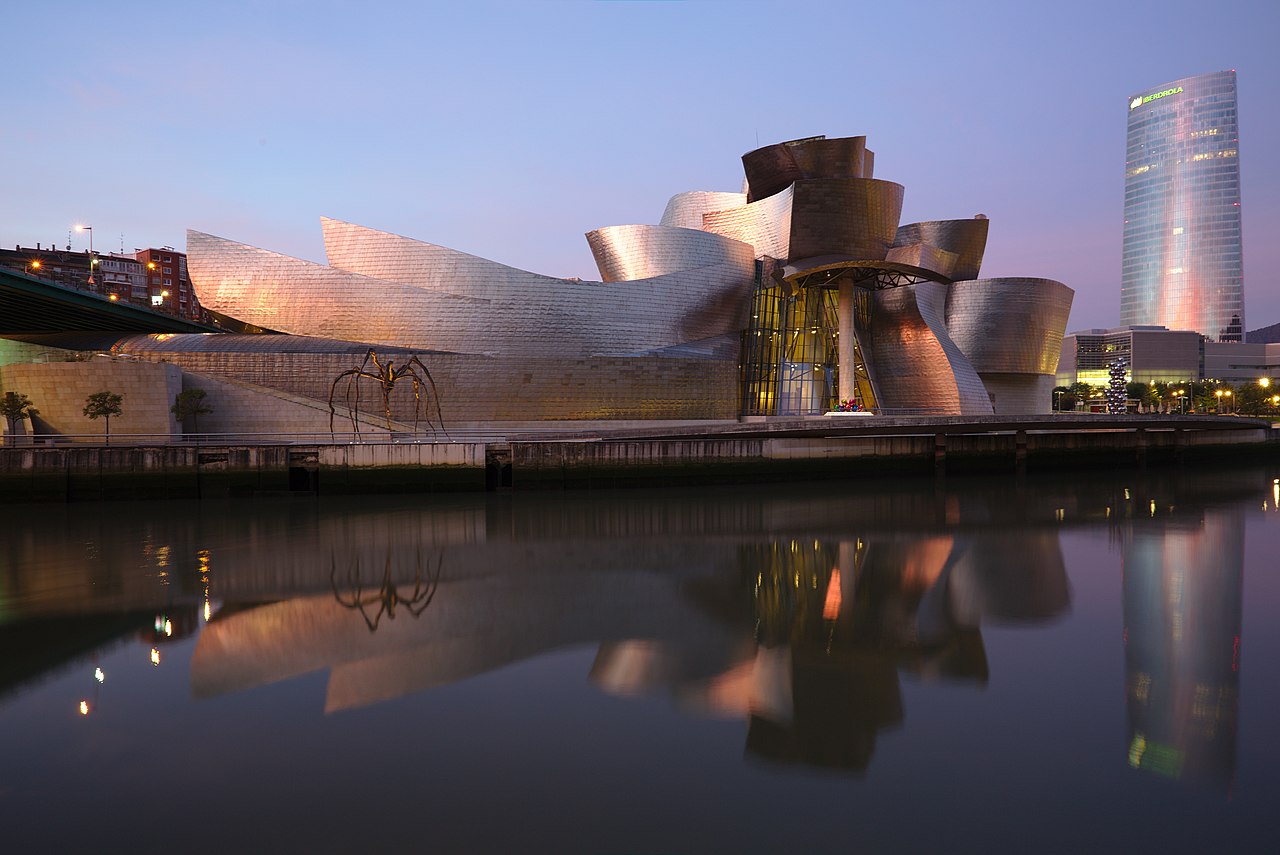
The Guggenheim Museum Bilbao in Bilbao, Spain, by Frank Gehry (1991-1997)
Prominent architects in Europe at the end of the 20th century included Jean Nouvel in France, noted for the Fondation Cartier and the Institut du Monde Arabe; the Swiss architect Jacques Herzog, who transformed the Bankside Power Station in London into the Tate Modern Gallery.
Preservation
Several works or collections of modern architecture have been designated by UNESCO as World Heritage Sites. In addition to the early experiments associated with Art Nouveau, these include a number of the structures mentioned above in this article: the Rietveld Schröder House in Utrecht, the Bauhaus structures in Weimar and Dessau, the Berlin Modernism Housing Estates, the White City of Tel Aviv, the city of Brasilia, the Ciudad Universitaria of UNAM in Mexico City and the University City of Caracas in Venezuela, and the Sydney Opera House.
Private organizations such as Docomomo International, the World Monuments Fund, and the Recent Past Preservation Network are working to safeguard and document imperiled Modern architecture. In 2006, the World Monuments Fund launched Modernism at Risk, an advocacy and conservation program.
Following the destruction caused by Hurricane Katrina, Modern structures in New Orleans have been increasingly slated for demolition. Plans are underway to demolish many of the city's Modern public schools, as well as large portions of the city's Civic Plaza. Federal Emergency Management Agency (FEMA) funds will contribute to razing the State Office Building and State Supreme Court Building, both designed by the collaborating architectural firms of August Perez and Associates; Goldstein, Parham and Labouisse; and Favrot, Reed, Mathes and Bergman. The New Orleans Recovery School District has proposed demolitions of schools designed by Charles R. Colbert, Curtis and Davis, and Ricciuti Associates. The 1959 Lawrence and Saunders building for the New Orleans International Longshoremen's Association Local 1419 is currently threatened with demolition although the union supports its conservation.

In 2007, the Sydney Opera House
by Jørn Utzon was listed as a World Heritage Site.
Kiến trúc hiện đại
Kiến trúc hiện đại hoặc kiến trúc hiện đại là một thuật ngữ áp dụng cho một nhóm các phong cách kiến trúc xuất hiện vào nửa đầu của thế kỷ 20 và trở nên nổi trội sau Chiến tranh thế giới II. Nó được dựa trên công nghệ xây dựng mới, đặc biệt là sử dụng thủy tinh, thép và bê tông cốt thép; Và khi từ chối kiến trúc tân cổ điển và phong cách Beaux-Arts nổi tiếng vào thế kỷ 19. Kiến trúc hiện đại tiếp tục là phong cách kiến trúc thống trị cho các tòa nhà thể chế và công ty vào những năm 1980, khi nó bị thách thức bởi chủ nghĩa hậu hiện đại, và sau đó là "chủ nghĩa hiện đại tân tiến" và các trường khác đã dần dần thay thế nó. Các kiến trúc sư nổi tiếng quan trọng đối với lịch sử và sự phát triển của phong trào hiện đại bao gồm Frank Lloyd Wright, Ludwig Mies van der Rohe, Le Corbusier, Walter Gropius, Konstantin Melnikov, Erich Mendelsohn, Richard Neutra, Louis Sullivan, Gerrit Rietveld, Bruno Taut, Gunnar Asplund, Arne Jacobsen, Oscar Niemeyer và Alvar Aalto.
Nguồn gốc
Kiến trúc hiện đại nổi lên vào cuối thế kỷ 19 từ những cuộc cách mạng về công nghệ, kỹ thuật và vật liệu xây dựng, và từ mong muốn tách rời các phong cách kiến trúc lịch sử và sáng tạo ra một cái gì đó hoàn toàn mới mẻ và mới mẻ. Cuộc cách mạng về nguyên liệu được tiến hành trước tiên, với việc sử dụng gang, thủy tinh và bê tông cốt thép, để xây dựng những cấu trúc mạnh mẽ, nhẹ nhàng và cao hơn. Quá trình xử lý kính đúc đã được phát minh vào năm 1848, cho phép sản xuất các cửa sổ rất lớn. Crystal Palace của Joseph Paxton tại Triển lãm lớn năm 1851 là một ví dụ đầu tiên của việc xây dựng bằng sắt và tấm kính, tiếp theo năm 1864 bởi bức tường kính và bức màn bằng kim loại đầu tiên. Những sự phát triển này đã dẫn tới tòa nhà chọc trời bằng thép đầu tiên, tòa nhà Bảo hiểm Nhà 10 tầng ở Chicago, được xây dựng vào năm 1884 bởi William Le Baron Jenney. Việc xây dựng khung sắt của tháp Eiffel, sau đó là cấu trúc cao nhất trên thế giới, đã chiếm được trí tưởng tượng của hàng triệu du khách đến Triển lãm Toàn cầu Paris 1889. Nhà công nghiệp Pháp François Coignet là người đầu tiên sử dụng bê tông cốt thép, tức là bê tông tăng cường bằng thanh sắt, như là một kỹ thuật để xây dựng các tòa nhà. Năm 1853 Coignet xây dựng cấu trúc bê tông cốt thép đầu tiên, một ngôi nhà bốn tầng ở ngoại ô Paris. Bước tiến quan trọng tiếp theo là sự phát minh ra thang máy an toàn của Elisha Otis, lần đầu tiên được chứng minh tại triển lãm Crystal Palace vào năm 1852, làm cho tòa nhà văn phòng và căn hộ cao cấp thực tiễn. Một công nghệ quan trọng khác cho kiến trúc mới là ánh sáng điện, làm giảm đáng kể nguy cơ cháy rừng do khí đốt vào thế kỷ 19. Sự xuất hiện của các tài liệu và kỹ thuật mới đã thu hút các kiến trúc sư phá vỡ các mô hình tân kỳ và cổ điển thống trị kiến trúc Châu Âu và Mỹ cuối thế kỷ 19, nổi bật nhất là kiến trúc chiết trung, kiến trúc Victoria và Edwardian, và kiểu kiến trúc Beaux-Arts. Sự phá vỡ này với quá khứ đặc biệt được thuyết phục bởi nhà lý thuyết kiến trúc và sử gia Eugène Viollet-le-Duc. Trong cuốn sách Entretiens sur l'Architecture năm 1872, ông đã thúc giục: "sử dụng các phương tiện và kiến thức được trao cho chúng ta theo thời đại của chúng ta, nếu không có những truyền thống can thiệp không còn hiệu quả ngày hôm nay, và theo cách đó chúng ta có thể khánh thành một kiến trúc mới. Chức năng vật liệu của nó, cho mỗi vật liệu hình dạng và vật trang trí của nó. " Cuốn sách này đã ảnh hưởng đến một thế hệ kiến trúc sư, bao gồm Louis Sullivan, Victor Horta, Hector Guimard và Antoni Gaudí.
Chủ nghĩa hiện đại thời kỳ đầu ở châu Âu (1900-1914)
Vào cuối thế kỷ 19, một vài kiến trúc sư bắt đầu thách thức các phong cách Beaux Arts và Neoclassical truyền thống thống trị kiến trúc ở châu Âu và Hoa Kỳ. Trường Nghệ thuật Glasgow năm 1896-99) do Charles Rennie MacIntosh thiết kế, có một mặt tiền bị chi phối bởi những vịnh lớn dọc của cửa sổ. Phong cách Art Nouveau được giới thiệu bởi Victor Horta ở Bỉ và Hector Guimard vào năm 1890 ở Pháp; Nó giới thiệu các phong cách trang trí mới, dựa trên các dạng thực vật và hoa. Ở Barcelona, Antonio Gaudi đã hình thành kiến trúc như một hình thức điêu khắc; Mặt tiền của Casa Battlo ở Barcelona (1904-1907) không có đường thẳng; Nó đã được bao phủ bởi các bức tranh khảm đầy màu sắc của đá và gạch men. Kiến trúc sư cũng bắt đầu thử nghiệm các vật liệu và kỹ thuật mới, tạo cho họ tự do hơn để tạo ra các hình thức mới. Năm 1903-1904 tại Paris Auguste Perret và Henri Sauvage bắt đầu sử dụng bê tông cốt thép, trước đây chỉ được sử dụng cho các công trình công nghiệp, để xây dựng các tòa nhà căn hộ. Bê tông cốt thép có thể đúc thành hình dạng bất kỳ và có thể tạo ra không gian khổng lồ mà không cần cột trụ, thay thế đá và gạch làm vật liệu chính cho các kiến trúc sư hiện đại. Các tòa nhà chung cư bê tông đầu tiên của Perret và Sauvage được phủ bằng gạch men, nhưng vào năm 1905 Perret xây dựng nhà để xe bê tông đầu tiên trên 51 rue de Ponthieu ở Paris; Ở đây bê tông còn trống, và không gian giữa bê tông đã được lấp đầy bằng cửa sổ kính. Henri Sauvage bổ sung thêm một cải tiến xây dựng trong một tòa nhà căn hộ trên đường Rue Vavin ở Paris (1912-1914); Tòa nhà bê tông cốt thép đã từng bước, với mỗi tầng được đặt từ tầng dưới, tạo ra hàng loạt các bậc thang. Từ năm 1910 đến năm 1913, Auguste Perret đã xây dựng Théâtre des Champs-Élysées, một kiệt tác của công trình bê tông cốt thép, với những bức chạm nổi Art Deco trên mặt tiền của Antoine Bourdelle. Do xây dựng bê tông nên không có cột ngăn cản quan điểm của khán giả về sân khấu. Otto Wagner, ở Vienna, là người tiên phong trong phong cách mới. Trong cuốn sách của ông Moderne Architektur (1895), ông đã kêu gọi xây dựng một phong cách kiến trúc hợp lý hơn, dựa trên "cuộc sống hiện đại". Ông đã thiết kế một ga tàu điện ngầm trang trí cách điệu ở Karlsplatz ở Vienna (1888-89), sau đó là nơi ở Art Nouveau trang trí, Nhà Majolika (1898), trước khi di chuyển sang một phong cách giản dị và giản dị hơn, không có trang trí, tại Ngân hàng Tiết kiệm Bưu điện Áo (1904-1906). Wagner tuyên bố ý định của mình để thể hiện các chức năng của tòa nhà bên ngoài của nó. Bề mặt bê tông cốt thép được bao phủ bằng những mảng đá cẩm thạch gắn với bu lông nhôm đánh bóng. Nội thất hoàn toàn có chức năng và phụ tùng, một không gian mở rộng của thép, thủy tinh và bê tông, nơi trang trí duy nhất là cấu trúc của chính nó.
Kiến trúc sư người Áo Adolf Loos cũng bắt đầu loại bỏ bất kỳ vật trang trí nào từ các tòa nhà của ông. Nhà Steiner của ông, ở Vienna (1910), là một ví dụ về cái ông gọi là kiến trúc duy lý; Nó có một mặt tiền hình chữ nhật đơn giản với cửa sổ vuông và không có đồ trang trí. . Sự nổi tiếng của phong trào mới, được biết đến dưới cái tên Secession Vienna, đã lan rộng ra ngoài Áo. Josef Hoffmann, một sinh viên của Wagner, đã xây dựng một dấu ấn của kiến trúc hiện đại hiện đại, Palais Stoclet, ở Brussels, vào năm 1906-1911. Khu nhà này, được xây bằng gạch được phủ đá cẩm thạch Na Uy, bao gồm các khối hình học, cánh và tháp. Một hồ bơi lớn phía trước nhà phản ánh hình khối của nó. Nội thất được trang trí bởi bức tranh của Gustav Klimt và các nghệ sĩ khác, và kiến trúc sư thậm chí còn thiết kế quần áo cho gia đình để phù hợp với kiến trúc. Tại Đức, một phong trào công nghiệp hiện đại, Deutscher Werkbund (Liên đoàn Lao động Đức) đã được Hermann Muthesius, một nhà bình luận kiến trúc nổi tiếng ở Munich thành lập năm 1907. Mục đích của nó là đưa các nhà thiết kế và các nhà công nghiệp vào việc tạo ra các sản phẩm có chất lượng cao, và trong quá trình phát minh ra một loại kiến trúc mới. Tổ chức ban đầu bao gồm mười hai kiến trúc sư và mười hai công ty kinh doanh, nhưng nhanh chóng mở rộng. Các kiến trúc sư bao gồm Peter Behrens, Theodor Fischer (người từng là chủ tịch đầu tiên), Josef Hoffmann và Richard Riemerschmid. Năm 1909, Behrens thiết kế một trong những tòa nhà công nghiệp sớm nhất và có ảnh hưởng nhất trong phong cách hiện đại, nhà máy sản xuất tuabin AEG, một tượng đài có chức năng bằng thép và bê tông. Trong những năm 1911-1913, Adolf Meyer và Walter Gropius, người đã làm việc cho Behrens, đã cách mạng xây dựng một nhà máy công nghiệp, nhà máy Fagus ở Alfeld an der Leine, một tòa nhà không có đồ trang trí, nơi phơi bày tất cả các cấu trúc xây dựng. Werkbund tổ chức một triển lãm lớn về thiết kế hiện đại tại Cologne chỉ vài tuần trước khi Chiến tranh Thế giới lần thứ nhất nổ ra vào tháng 8 năm 1914. Trong triển lãm Cologne năm 1914, Bruno Taut đã cách mạng xây dựng một gian nhà toàn kính.
Chủ nghĩa hiện đại thời Mỹ (1900-1914)
Frank Lloyd Wright là một kiến trúc sư Mỹ gốc độc lập và độc lập, người từ chối phân loại trong bất kỳ phong trào kiến trúc nào. Giống như Le Corbusier và Ludwig Mies van der Rohe, anh ta không hề được đào tạo về kiến trúc chính thức. Trong những năm 1887-93, ông làm việc tại văn phòng của ông Louis Sullivan ở Chicago, người đi tiên phong trong việc xây dựng các cao ốc văn phòng cao cấp đầu tiên ở Chicago, và người nổi tiếng nói rằng "hình thức theo chức năng". Wright đặt ra để phá vỡ tất cả các quy tắc truyền thống. Wright nổi tiếng với những ngôi nhà Prairie của ông, bao gồm Nhà Winslow ở River Forest, Illinois (1893-94), Arthur Heurtley House (1902) và Robie House (1909); Các căn hộ hình học không có trang trí, với các đường ngang ngang mạnh dường như phát triển ra khỏi trái đất, và nó đã vang vọng không gian phẳng của thảo nguyên Mỹ. Tòa nhà Larkin (1904-1906) của ông ở Buffalo, New York, Đền Unity (1905) ở Oak Park, Illinois và Đền Unity có các hình thức ban đầu rất cao và không có liên hệ với tiền lệ lịch sử.
Sự ra đời của nhà chọc trời
Vào cuối thế kỷ 19, những tòa nhà chọc trời đầu tiên bắt đầu xuất hiện ở Hoa Kỳ. Họ là một phản ứng đối với tình trạng thiếu đất và chi phí bất động sản cao ở trung tâm của các thành phố đang phát triển nhanh ở Mỹ và sự sẵn có của các công nghệ mới, bao gồm khung thép chịu lửa và cải tiến thang máy an toàn do Elisha Otis sáng tạo năm 1852. "Nhà chọc trời" khung thép đầu tiên, Tòa nhà Bảo hiểm Nhà ở Chicago, cao 10 tầng. Nó được thiết kế bởi William Le Baron Jenney vào năm 1883, và đã được một thời gian ngắn tòa nhà cao nhất thế giới. Nó đã vượt qua bởi (Bảo hiểm Nhà ở) của Louis Sullivan ở Buffalo, New York. Sullivan xây dựng một công trình kiến trúc mới khác, Carson, Pirie, Scott và Công ty Xây dựng, ở trung tâm Chicago vào năm 1904-06. Trong khi các tòa nhà này là cách mạng trong khung thép và chiều cao của họ, thiết kế mặt tiền của họ có trong kiến trúc tân cổ truyền Neo-Gothic và Beaux-Arts truyền thống hơn. Toà nhà Woolworth được thiết kế bởi Cass Gilbert đã được hoàn thành vào năm 1912 và là tòa nhà cao nhất thế giới cho đến khi hoàn thành tòa nhà Chrysler vào năm 1929. Ngoại thất của nó theo phong cách Neo-Gothic, hoàn chỉnh với các giá đỡ trang trí, vòm vòm và ngọn tháp , Gây ra nó được đặt biệt danh là "Nhà thờ Thương mại".
Sự nổi lên của chủ nghĩa hiện đại (1919-1930)
Sau chiến tranh thế giới thứ nhất, cuộc đấu tranh kéo dài giữa các kiến trúc sư ưa chuộng các phong cách tân cổ điển và phong cách kiến trúc Beaux-Arts hơn, và các nhà hiện đại, dưới sự chỉ đạo của Le Corbusier và Robert Mallet-Stevens ở Pháp, Walter Gropius và Ludwig Mies van der Rohe ở Đức, và Konstantin Melnikov ở Liên bang Xô viết mới, những người chỉ muốn các hình thức thuần túy và loại bỏ bất kỳ trang trí nào. Các kiến trúc sư Art Deco như Auguste Perret và Henri Sauvage thường tạo ra một sự thỏa hiệp giữa hai, kết hợp các hình thức hiện đại và trang trí cách điệu.
Le Corbusier và Mallet-Stevens
Con số thống trị trong sự nổi lên của chủ nghĩa hiện đại ở Pháp là Charles-Édouard Jeanneret, một kiến trúc sư Thụy Sĩ-Pháp vào năm 1920 lấy tên là Le Corbusier. Năm 1920 ông đồng sáng lập một tạp chí mang tên "L'Espirit Nouveau" và hăng hái đẩy mạnh kiến trúc có chức năng, thanh tịnh, và không có bất cứ sự kết hợp trang trí hoặc lịch sử nào. Ông cũng là một người ủng hộ nhiệt tình của một chủ nghĩa đô thị mới, dựa trên các thành phố quy hoạch. Năm 1922, ông trình bày một thiết kế của một thành phố cho ba triệu người, có cư dân sống trong tòa nhà chọc trời cao sáu mươi tầng giống nhau bao quanh bởi công viên mở. Ông đã thiết kế những ngôi nhà kiểu mô-đun, sẽ được sản xuất hàng loạt trên cùng một kế hoạch và lắp ráp thành các khu chung cư, các khu phố và các thành phố. Vào năm 1923, ông đã xuất bản "Hướng tới một kiến trúc", với khẩu hiệu nổi tiếng của mình, "một ngôi nhà là một cái máy để sinh sống." Ông không ngừng quảng bá ý tưởng của mình qua khẩu hiệu, bài báo, sách, hội nghị, và tham gia Triển lãm. Để minh họa ý tưởng của mình, trong những năm 1920, ông đã xây dựng một loạt nhà ở và biệt thự trong và quanh Paris. Tất cả đều được xây dựng theo một hệ thống chung, dựa trên việc sử dụng bê tông cốt thép, và các giá đỡ bê tông cốt thép trong nội thất có hỗ trợ cấu trúc, cho phép các bức tường rèm kính trên mặt tiền và các kế hoạch sàn nhà, độc lập với cấu trúc. Họ luôn trắng, không trang trí hoặc trang trí ở bên ngoài hoặc bên trong. Nhà nổi tiếng nhất là Villa Savoye, được xây dựng vào năm 1928-1931 ở ngoại ô Poissy ở Paris. Một chiếc hộp màu trắng thanh lịch được bao bọc bởi một dải băng kính xung quanh mặt tiền, với không gian sống mở ra trên một khu vườn bên trong và vùng nông thôn xung quanh, được dựng lên bởi một hàng cột màu trắng ở trung tâm một bãi cỏ lớn, nó trở thành một biểu tượng của Kiến trúc hiện đại.
Bauhaus và Werkbund Đức
Ở Đức, hai phong trào hiện đại quan trọng xuất hiện sau Thế chiến thứ nhất, Bauhaus là một trường tổ chức Weimar năm 1919 dưới sự chỉ đạo của Walter Gropius. Gropius là con của kiến trúc sư chính thức của Béc-lin, người đã học trước chiến tranh với Peter Behrens và thiết kế nhà máy tuabin Fagus hiện đại. Bauhaus là sự pha trộn của Học viện Nghệ thuật Trước chiến tranh và trường công nghệ. Năm 1926 nó được chuyển từ Weimar đến Dessau; Gropius đã thiết kế trường học mới và ký túc xá cho sinh viên theo phong cách hiện đại mới, thuần túy theo phong cách hiện đại mà ông khuyến khích. Trường đã tập hợp các nhà hiện đại vào mọi lĩnh vực; Các giảng viên bao gồm các họa sỹ hiện đại Vasily Kandinsky, Joseph Albers và Paul Klee, và nhà thiết kế Marcel Breuer.
Gropius trở thành một nhà lý thuyết quan trọng của chủ nghĩa hiện đại, viết '' Ý tưởng và Xây dựng '' vào năm 1923. Ông là người bênh vực cho tiêu chuẩn hóa kiến trúc, và việc xây dựng khối nhà chung cư được thiết kế hợp lý cho công nhân nhà máy. Năm 1928, ông được uỷ nhiệm bởi công ty Siemens để xây dựng căn hộ cho người lao động ở ngoại ô Berlin, và năm 1929, ông đề xuất xây dựng các cụm tháp căn hộ cao cấp tháp từ 8 đến 10 tầng cho công nhân. Trong khi Gropius hoạt động tại Bauhaus, Ludwig Mies van der Rohe đã dẫn đầu phong trào kiến trúc hiện đại ở Berlin. Lấy cảm hứng từ phong trào De Stijl ở Hà Lan, ông xây dựng các cụm nhà ở mùa hè bằng bê tông và đề xuất một dự án cho một tháp văn phòng kính. Ông trở thành phó chủ tịch của "Werkbund" của Đức, và trở thành người đứng đầu của Bauhaus từ năm 1930 đến 1932. đề xuất một loạt các kế hoạch hiện đại cho tái thiết đô thị. Tác phẩm hiện đại nổi tiếng nhất của ông là gian hàng của Đức cho triển lãm quốc tế năm 1929 tại Barcelona. Đó là một tác phẩm của chủ nghĩa hiện đại thuần túy, với những bức tường bằng kính và bê tông và các đường kẻ ngang trong sạch. Mặc dù nó chỉ là một cấu trúc tạm thời, và bị xé vào năm 1930, nó đã trở thành, cùng với Villa Savoye của Le Corbusier, một trong những kiến trúc hiện đại nổi tiếng nhất. Một phiên bản đã được tái tạo hiện nay nằm trên trang web gốc ở Barcelona. Khi Đức quốc xã lên nắm quyền ở Đức, họ xem Bauhaus làm nền móng cho những người cộng sản, và đóng cửa trường học vào năm 1932. Gropius rời nước Đức và đi Anh quốc, sau đó đến Hoa Kỳ, nơi ông và Marcel Breuer cùng gia nhập khoa Của Trường Thiết kế Đại học Harvard, và trở thành giáo viên của một thế hệ các kiến trúc sư Mỹ sau chiến tranh. Năm 1937 Mies van der Rohe cũng chuyển đến Hoa Kỳ; Ông trở thành một trong những nhà thiết kế nổi tiếng nhất của những tòa nhà chọc trời ở Mỹ.
Chủ nghĩa biểu hiện Đức (1919-1933)
Chủ nghĩa biểu hiện, xuất hiện ở Đức từ năm 1910 đến năm 1925, là một cuộc phản công chống lại các kiến trúc chức năng nghiêm ngặt của Bauhaus và Werkbund. Những người ủng hộ của nó, bao gồm Bruno Taut, Hans Poelzig, Fritz Hoger và Erich Mendelsohn, muốn tạo ra kiến trúc thơ ca, diễn cảm và lạc quan. Nhiều kiến trúc sư chuyên nghiệp đã từng chiến đấu trong Thế chiến I và những kinh nghiệm của họ, kết hợp với những bất ổn chính trị và biến động xã hội theo sau cuộc Cách mạng Đức năm 1919, dẫn đến một viễn cảnh không tưởng và một chương trình nghị sự xã hội lãng mạn. Các điều kiện kinh tế đã hạn chế số lượng các ủy ban xây dựng từ năm 1914 đến giữa những năm 1920. Do đó, nhiều dự án mang tính biểu tượng sáng tạo nhất, bao gồm Kiến trúc Alpine của Bruno Taut và Formspiels của Hermann Finsterlin, vẫn còn trên giấy tờ. Scenography cho sân khấu và phim ảnh đã tạo ra một lối thoát cho trí tưởng tượng chủ nghĩa hiện thực và cung cấp thêm thu nhập cho các nhà thiết kế cố gắng thách thức các công ước trong một môi trường kinh tế khắc nghiệt. Một loại đặc biệt, sử dụng gạch để tạo thành các dạng của nó (chứ không phải là bê tông) được gọi là chủ nghĩa biểu hiện Brick. Erich Mendelsohn (người không thích thuật ngữ chủ nghĩa biểu hiện cho công việc của mình) bắt đầu sự nghiệp của mình thiết kế các nhà thờ, xilô, và các nhà máy giàu trí tưởng tượng, nhưng, vì thiếu nguồn lực, chưa bao giờ được xây dựng Trong năm 1920, cuối cùng ông đã có thể xây dựng một Làm việc ở thành phố Potsdam; Một trung tâm quan sát và nghiên cứu được gọi là Einsteinium, được đặt tên theo sự tôn vinh của Albert Einstein. Nó được cho là được xây dựng bằng bê tông cốt thép, nhưng do các vấn đề kỹ thuật nên nó được xây dựng cuối cùng bằng các vật liệu truyền thống được phủ bằng thạch cao. Hình dáng điêu khắc của ông, rất khác với các hình chữ nhật khắc nghiệt của Bauhaus, lần đầu tiên ông giành được hoa hồng để xây dựng rạp chiếu phim và các cửa hàng bán lẻ ở Stuttgart, Nuremberg và Berlin. Mossehaus của ông ở Berlin là một mô hình ban đầu cho phong cách moderne hiện đại. Columbushaus của ông trên quảng trường Potsdamer Platz ở Berlin (1931) là một mẫu thử nghiệm cho các tòa nhà văn phòng hiện đại theo sau. (Nó bị xé vào năm 1957 vì nó nằm trong khu vực giữa Đông và Tây Berlin, nơi bức tường Berlin được xây dựng) Sau khi Đức Quốc xã lên nắm quyền, ông chuyển đến Anh (1933), sau đó đến Hoa Kỳ (1941). Fritz Höger là một kiến trúc sư kỳ cựu nổi tiếng của thời kỳ này. Chilêla của ông được xây dựng làm trụ sở của một công ty vận tải, và được mô phỏng theo một chiếc tàu hơi nước khổng lồ, một tòa nhà tam giác với mũi nhọn. Nó được xây bằng gạch tối màu, và sử dụng bệ bên ngoài để thể hiện cấu trúc theo chiều dọc của nó. Trang trí bên ngoài của nó mượn từ nhà thờ Gothic, cũng như các cửa hàng nội thất của nó. Hans Poelzig là một kiến trúc sư biểu hiện nổi tiếng khác. Năm 1919, ông xây dựng Großes Schauspielhaus, một rạp hát khổng lồ ở Béc-lin, với sức chứa năm nghìn khán giả cho nhà hùng biện Max Reinhardt. Nó đặc trưng hình dạng dài như đá mạt treo xuống từ mái vòm khổng lồ của nó, và đèn trên các cột lớn trong tiền sảnh của nó. Ông cũng đã xây dựng tòa nhà IG Farben, một trụ sở của tập đoàn khổng lồ, nay là tòa nhà chính của Đại học Goethe ở Frankfurt. Bruno Taut chuyên xây dựng các khu chung cư quy mô lớn dành cho tầng lớp lao động Berlin. Ông đã xây dựng được mười hai nghìn đơn vị riêng biệt, đôi khi trong các tòa nhà với những hình dạng bất thường, chẳng hạn như móng ngựa khổng lồ. Không giống như hầu hết các nhà hiện đại khác, ông đã sử dụng màu sắc bên ngoài tươi sáng để tạo cho tòa nhà của mình thêm cuộc sống Việc sử dụng gạch bóng tối trong các dự án của Đức đã mang lại cho một phong cách đặc biệt đó là Brick Expressionism. Nhà triết học người Áo, kiến trúc sư và nhà phê bình xã hội, Rudolf Steiner, cũng đã rời xa những hình kiến trúc truyền thống nhất có thể. Goetheanum thứ hai của ông, được xây dựng từ năm 1926 gần Basel, Thụy Sĩ, Einsteinturm ở Potsdam, Đức, và Goetheanum thứ hai, Rudolf Steiner (1926), không dựa trên các mô hình truyền thống và có hình dạng hoàn toàn nguyên bản.
Chủ nghĩa thi đua Xô viết (1919-1930)
Sau Cách mạng Nga năm 1917, các nghệ sỹ và kiến trúc sư tiên phong Nga đã bắt đầu tìm kiếm một phong cách Xô viết mới có thể thay thế cho chủ nghĩa tân cổ điển. Các phong trào kiến trúc mới gắn chặt với các phong trào văn chương và nghệ thuật thời kỳ này, chủ nghĩa tương lai của nhà thơ Vladimir Mayakovskiy, chủ nghĩa Suprematism của họa sĩ Kasimir Malevich, và họa tiết hào quang của họa sĩ Mikhail Larionov. Thiết kế gây sửng sốt nhất đã xuất hiện là tháp do họa sĩ và họa sĩ Vladimir Tatlin đề xuất cho cuộc họp Moscow lần thứ ba của Quốc hội Cộng sản Quốc tế lần thứ ba năm 1920: ông đã đề xuất hai tháp kim loại xen kẽ với chiều cao bốn trăm mét, với bốn khối hình học bị treo lơ lửng. Phong trào xây dựng kiến trúc Nga đã được đưa ra vào năm 1921 bởi một nhóm các nghệ sĩ do Aleksandr Rodchenko đứng đầu. Tuyên ngôn của họ tuyên bố rằng mục tiêu của họ là tìm ra "sự biểu hiện của cộng sản về cấu trúc vật chất". Các kiến trúc sư Liên Xô đã bắt đầu xây dựng các câu lạc bộ công nhân, nhà chung cư và nhà bếp chung cho cả khu phố. Một trong những kiến trúc sư xây dựng nổi bật đầu tiên xuất hiện ở Moscow là Konstantin Melnikov, số lượng các câu lạc bộ làm việc - bao gồm Câu lạc bộ Người lao động Rusakov (1928) - và ngôi nhà riêng của ông, Melnikov House (1929) gần Arbat Street ở Moscow. Melnikov đã đến Paris vào năm 1925, nơi ông đã xây dựng Khu Liên Xô cho Triển lãm quốc tế về Nghệ thuật trang trí và Công nghiệp hiện đại ở Paris năm 1925; Đó là một cấu trúc thẳng đứng theo hình học của thủy tinh và thép cắt ngang bởi một cầu thang chéo, và vương miện bằng một cái búa và lưỡi liềm. Nhóm kiến trúc sư xây dựng hàng đầu do Vesnin Brothers và Moisei Ginzburg dẫn đầu đã xuất bản tạp chí 'Contemporary Architecture'. Nhóm này đã tạo ra một số dự án xây dựng chủ yếu sau Kế hoạch 5 năm đầu tiên bao gồm cả Trạm thủy điện Dnepney khổng lồ (1932) - và đã cố gắng để bắt đầu chuẩn hóa các khối nhà với tòa nhà Narkomfin của Ginzburg. Một số kiến trúc sư từ thời kỳ tiền Xô viết cũng đã theo phong cách xây dựng. Ví dụ nổi tiếng nhất là Lăng mộ của Lenin ở Moscow (1924), bởi Alexey Shchusev (1924). Các trung tâm chính của kiến trúc xây dựng là Moscow và Leningrad; Tuy nhiên, trong quá trình công nghiệp hóa, nhiều tòa nhà xây dựng đã được dựng lên ở các thành phố của tỉnh. Các trung tâm công nghiệp khu vực, bao gồm Ekaterinburg, Kharkiv hay Ivanovo, được xây dựng lại theo cách xây dựng; Một số thành phố, như Magnitogorsk hay Zaporizhia, được xây dựng mới (cái gọi là socgorod, hay 'thành phố xã hội chủ nghĩa').
Phong cách này nổi bật trong số những năm 1930, thay thế bằng phong cách dân tộc chủ nghĩa mà Stalin ưa thích hơn. Các nhà kiến trúc xây dựng và thậm chí các dự án của Le Corbusier cho Cung điện mới của Liên Xô từ năm 1931 đến năm 1933, nhưng người chiến thắng là một toà nhà Stalinist sớm theo kiểu Postconstructivism. Toà nhà xây dựng xây dựng cuối cùng của Nga, do Boris Iofan, xây dựng cho Triển lãm Thế giới Paris (1937), nơi kiến trúc Albert Speer của Hitler phải đối mặt với gian hàng của Đức quốc xã.
Chủ nghĩa hiện đại trở thành một phong trào - CIAM (1928)
Vào cuối những năm 1920, chủ nghĩa hiện đại đã trở thành một phong trào quan trọng ở châu Âu. Kiến trúc, vốn trước đây chủ yếu là quốc gia, bắt đầu trở thành quốc tế. Các kiến trúc sư đi, gặp nhau và chia sẻ ý tưởng. Một số nhà hiện đại, bao gồm cả Le Corbusier, đã tham gia cuộc thi cho trụ sở Liên đoàn các quốc gia vào năm 1927. Trong cùng năm đó, Đức Werkbund tổ chức một triển lãm kiến trúc tại Weissenhof Estate Stuttgart. Mười bảy nhà kiến trúc hiện đại hàng đầu ở Châu Âu được mời thiết kế 21 căn nhà; Le Corbusier, và Ludwig Mies van der Rohe đóng vai trò quan trọng. Năm 1927 Le Corbusier, Pierre Chareau và những người khác đề xuất nền tảng của một hội nghị quốc tế để thiết lập cơ sở cho một phong cách chung. Cuộc họp đầu tiên của Congrès Internationaux d'Architecture Moderne hay các Đại hội Kiến trúc Hiện đại Quốc tế (CIAM) được tổ chức tại lâu đài Lake Leman ở Thụy Sĩ từ ngày 26 đến 28 tháng 4 năm 1928. Những người tham dự bao gồm Le Corbusier, Robert Mallet-Stevens, Auguste Perret, Pierre Chareau và Tony Garnier từ Pháp; Victor Bourgeois từ Bỉ; Walter Gropius, Erich Mendelsohn, Ernst May và Ludwig Mies van der Rohe từ Đức; Josef Frank từ Áo; Mart Stam và Gerrit Rietveld từ Hà Lan, và Adolf Loos từ Tiệp Khắc. Một phái đoàn của kiến trúc sư Liên Xô được mời tham dự, nhưng họ không thể có được thị thực. Các thành viên sau đó bao gồm Josep Lluís Sert của Tây Ban Nha và Alvar Aalto của Phần Lan. Không ai tham dự từ Hoa Kỳ. Một cuộc họp thứ hai được tổ chức vào năm 1930 tại Brussels bởi Victor Bourgeois về chủ đề "Các phương pháp hợp lý cho các nhóm cư trú". Cuộc họp thứ ba, trong "Thành phố chức năng", đã được lên kế hoạch cho Moscow vào năm 1932, nhưng đã bị hủy vào phút cuối. Thay vào đó, các đại biểu đã tổ chức cuộc họp của họ trên một chiếc tàu du lịch đi du lịch giữa Marseille và Athens. Trên tàu, họ cùng nhau soạn thảo một văn bản về cách thức tổ chức các thành phố hiện đại. Văn bản, được gọi là Hiến chương Athens, sau khi được chỉnh sửa bởi Corbusier và những người khác, cuối cùng được xuất bản năm 1957 và trở thành một văn bản có ảnh hưởng cho các nhà quy hoạch thành phố trong những năm 1950 và 1960. Nhóm đã gặp lại Paris lần nữa tại Paris năm 1937 để thảo luận về nhà ở công cộng và dự kiến sẽ gặp nhau tại Hoa Kỳ vào năm 1939, nhưng cuộc họp đã bị huỷ bỏ do chiến tranh. Di sản của CIAM là một phong cách chung và học thuyết giúp xác định kiến trúc hiện đại ở châu Âu và Hoa Kỳ sau Chiến tranh thế giới II.





No comments:
Post a Comment